
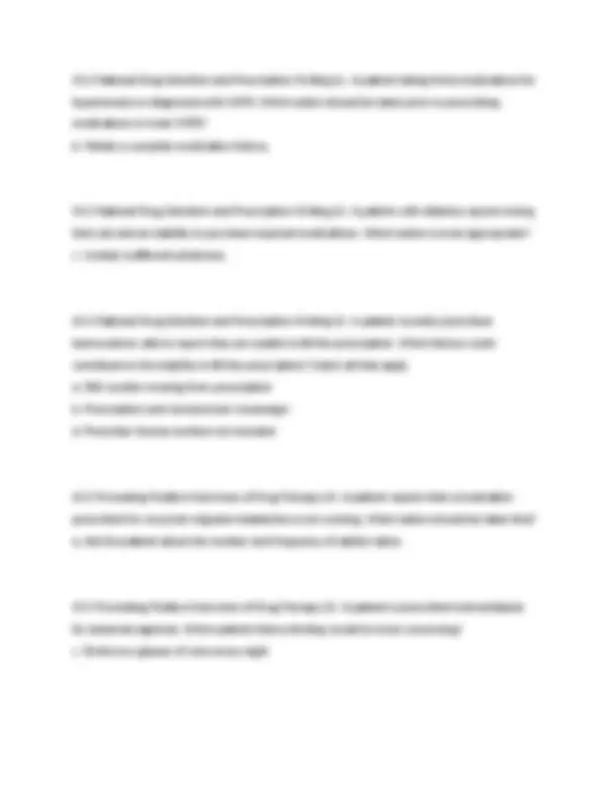
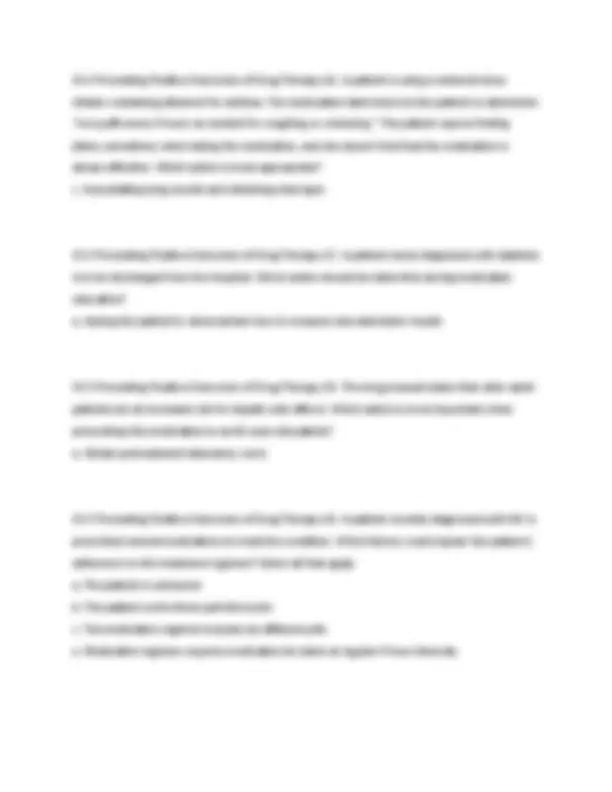
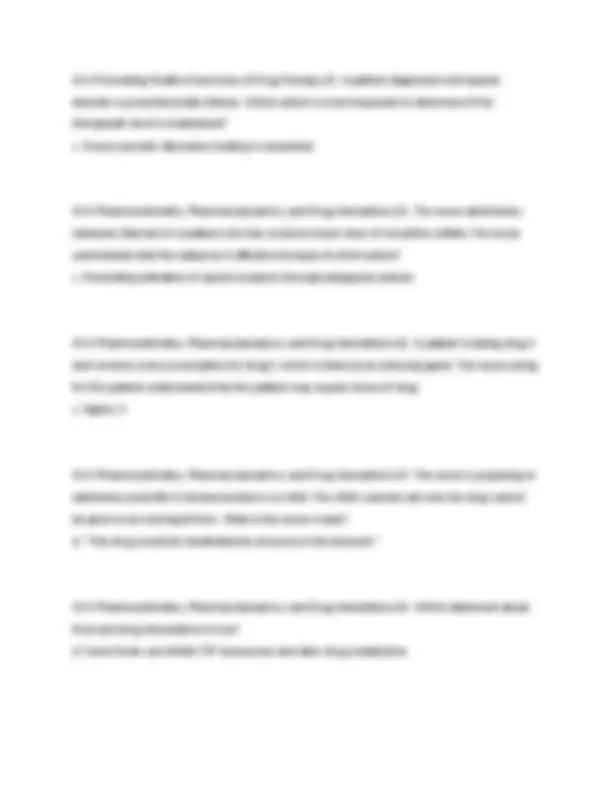

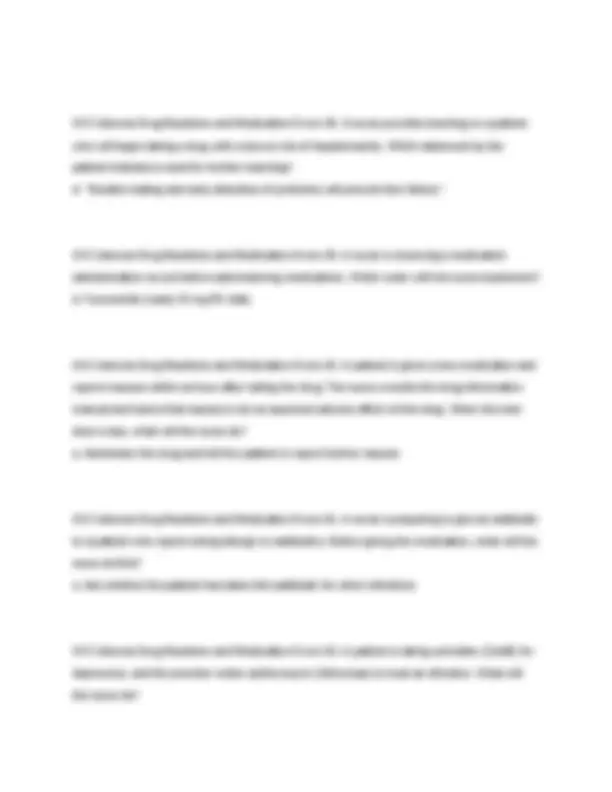
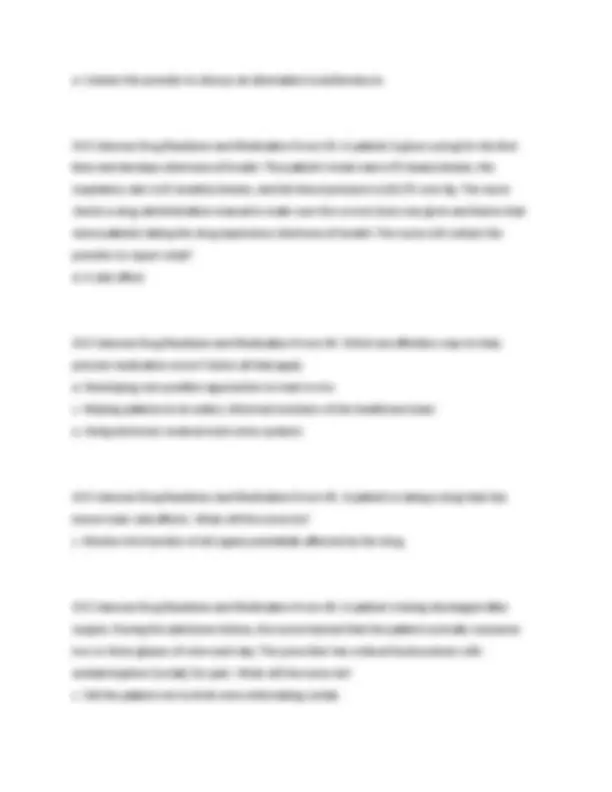
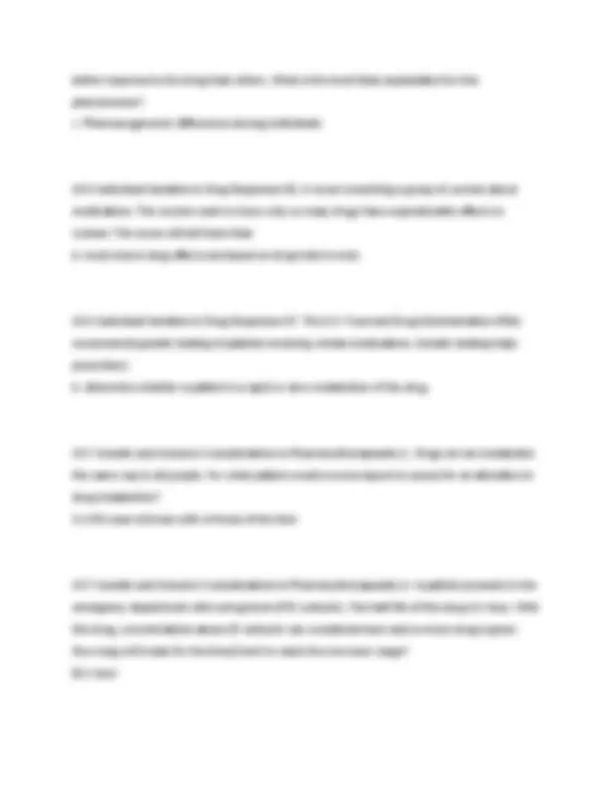
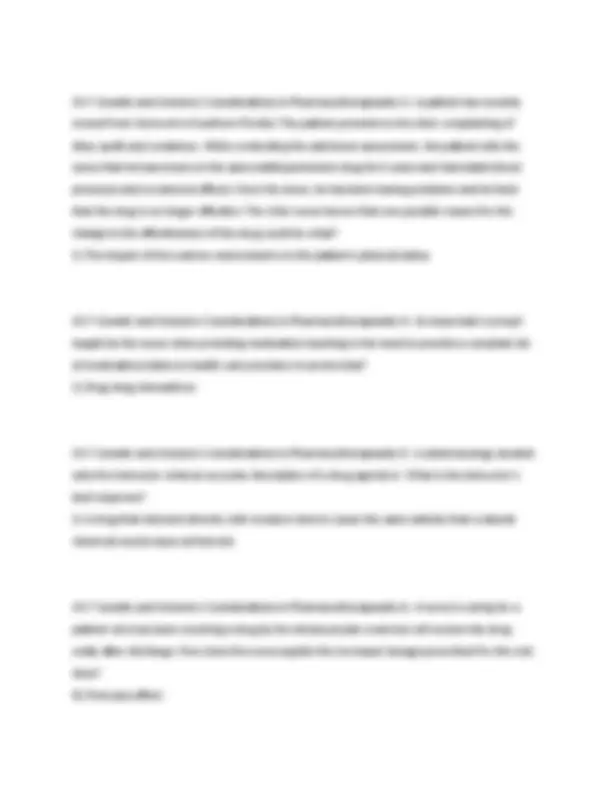
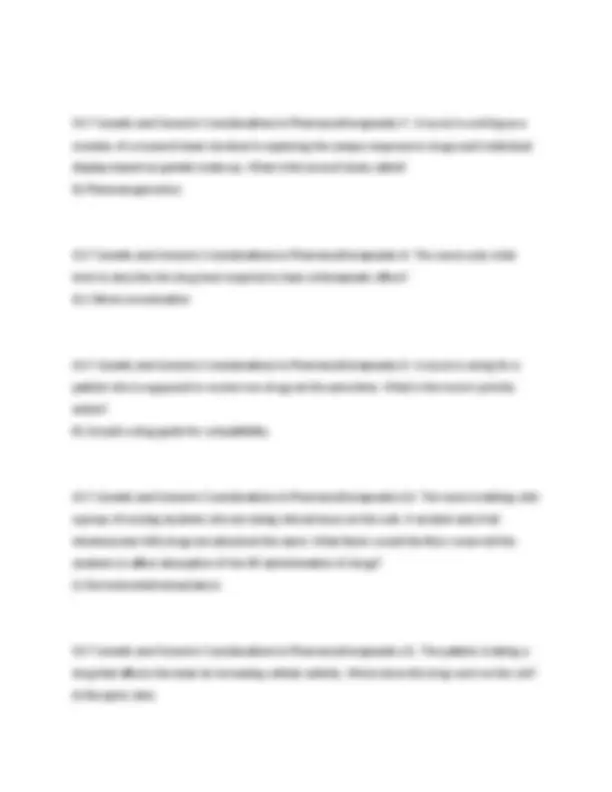
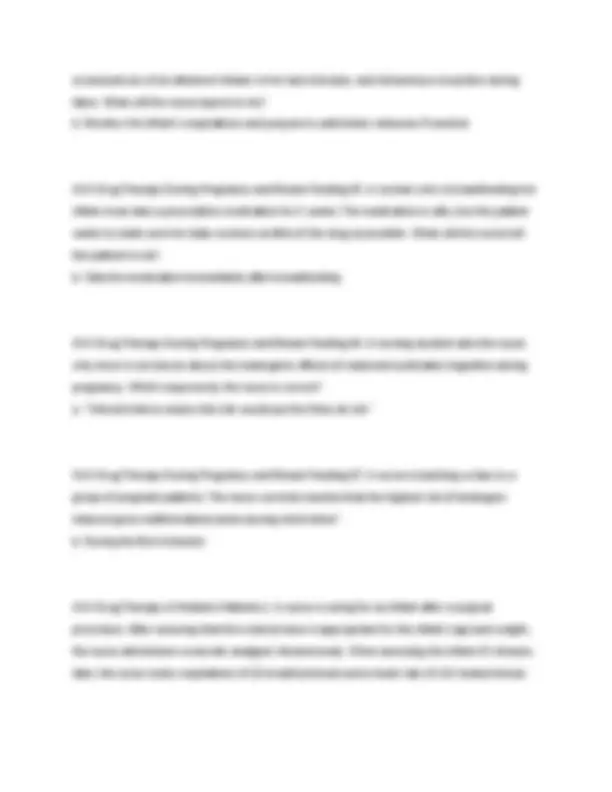
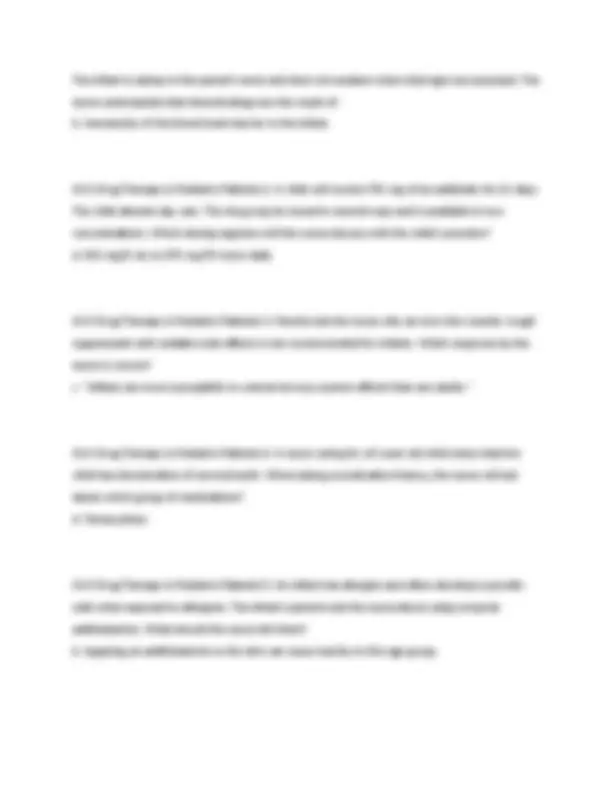
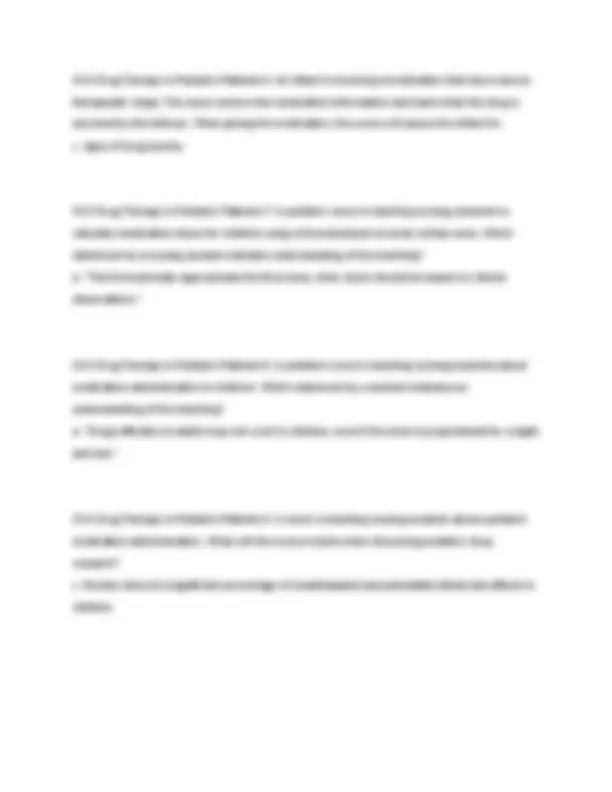
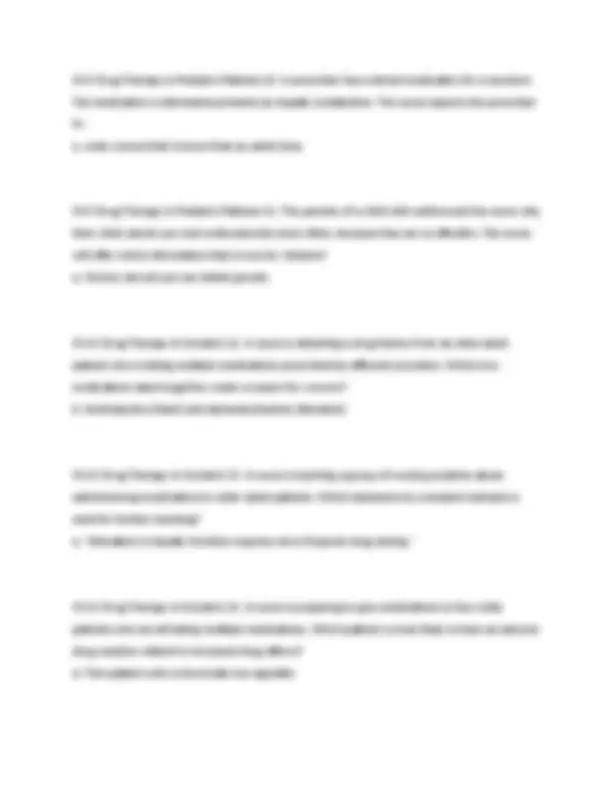
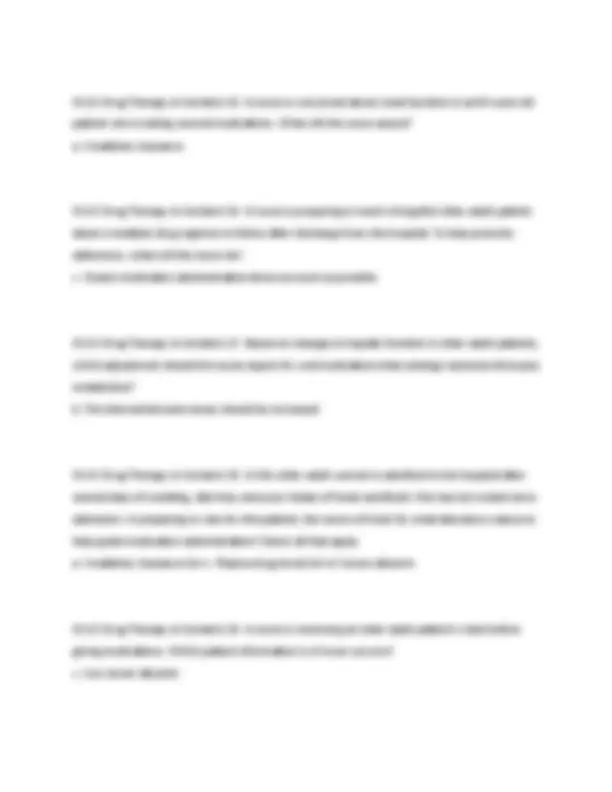
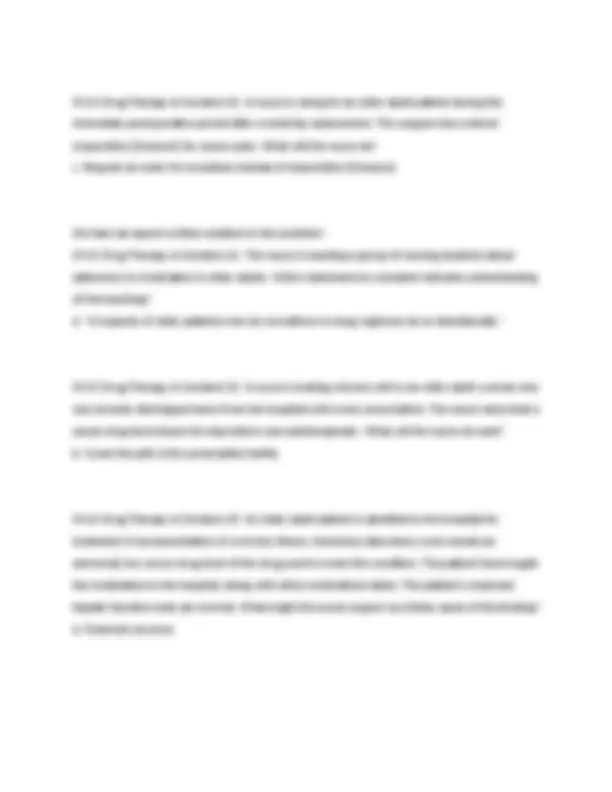
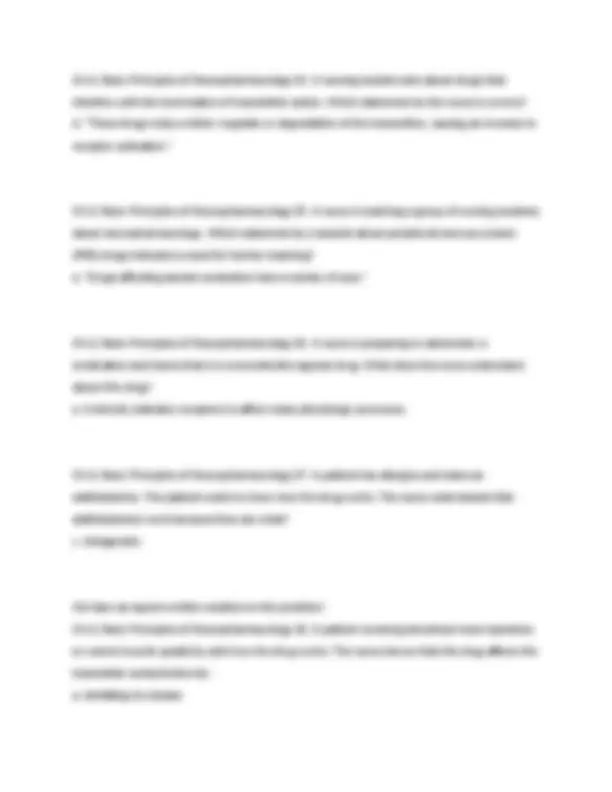
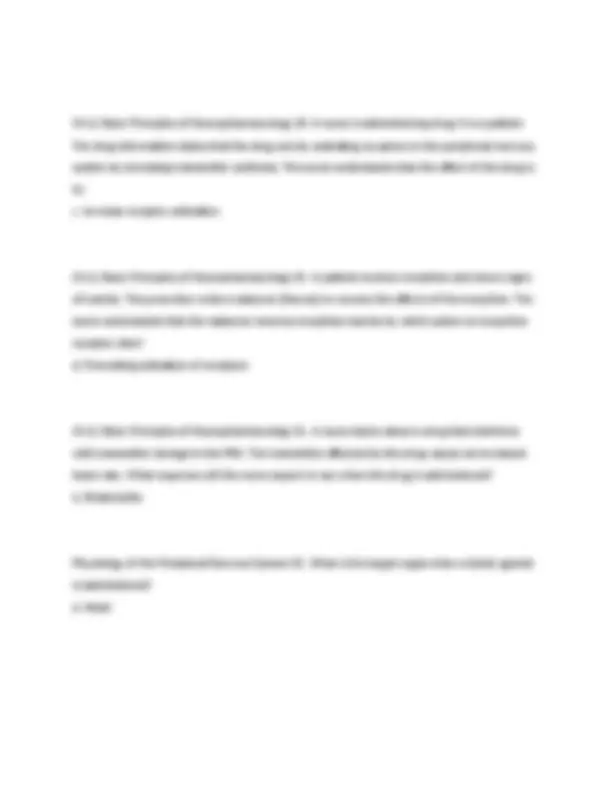
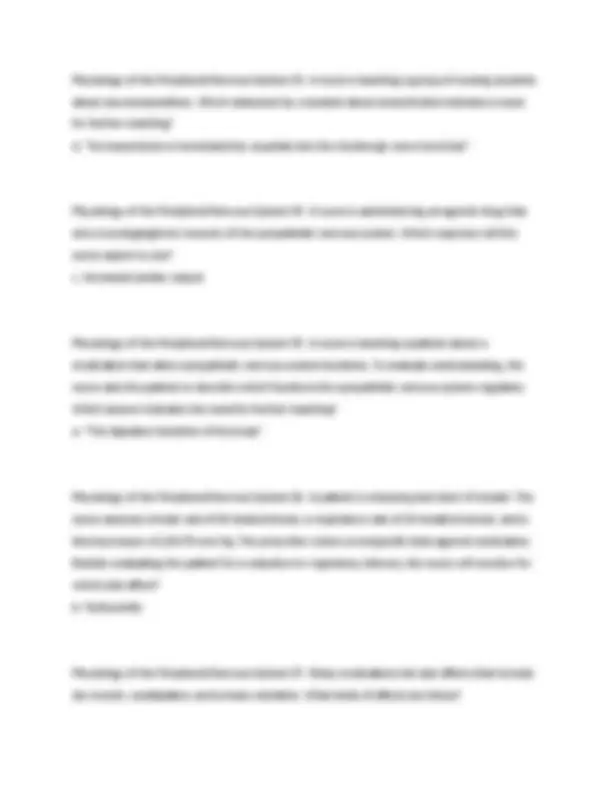
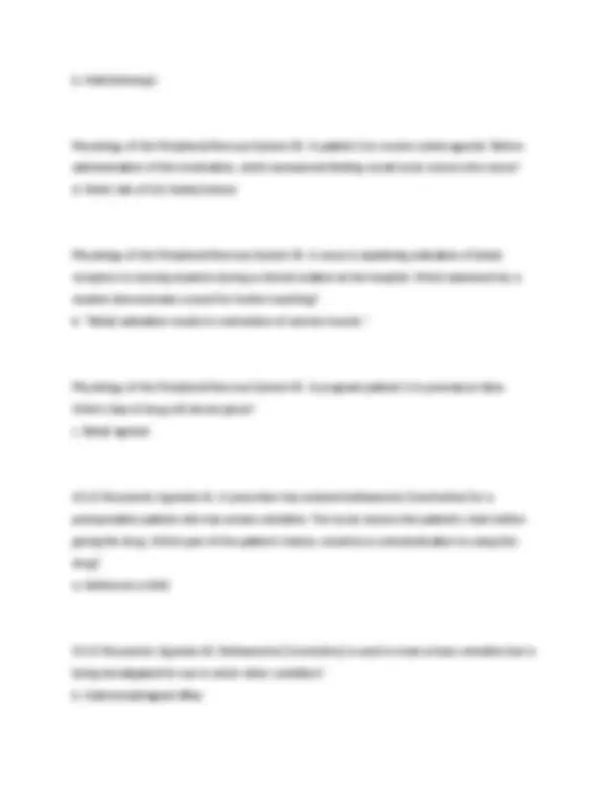
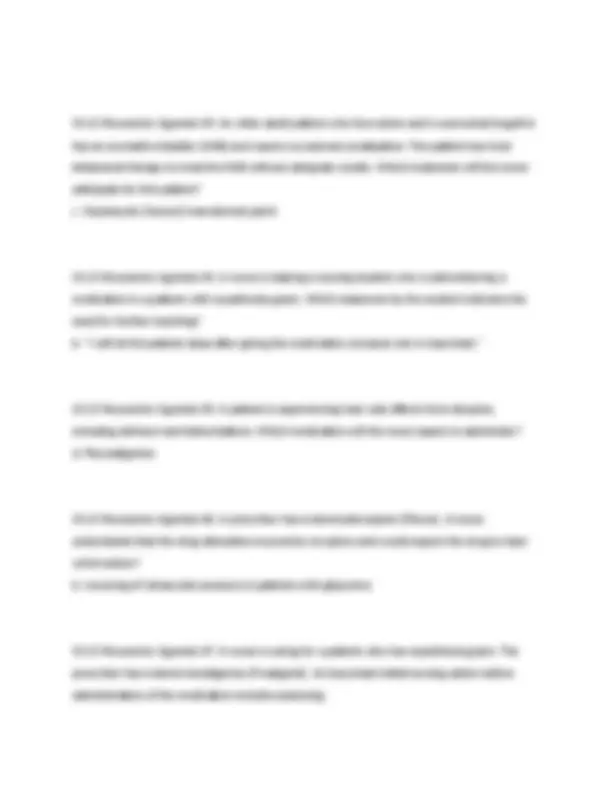
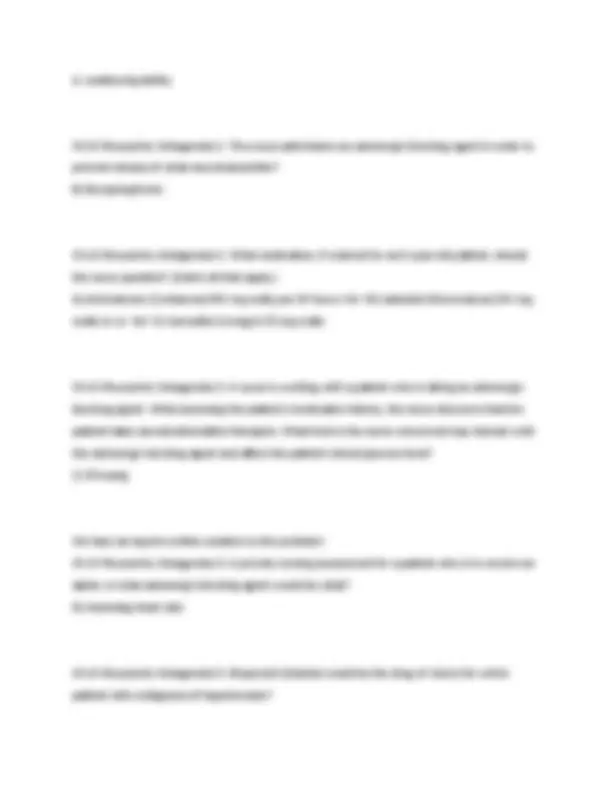
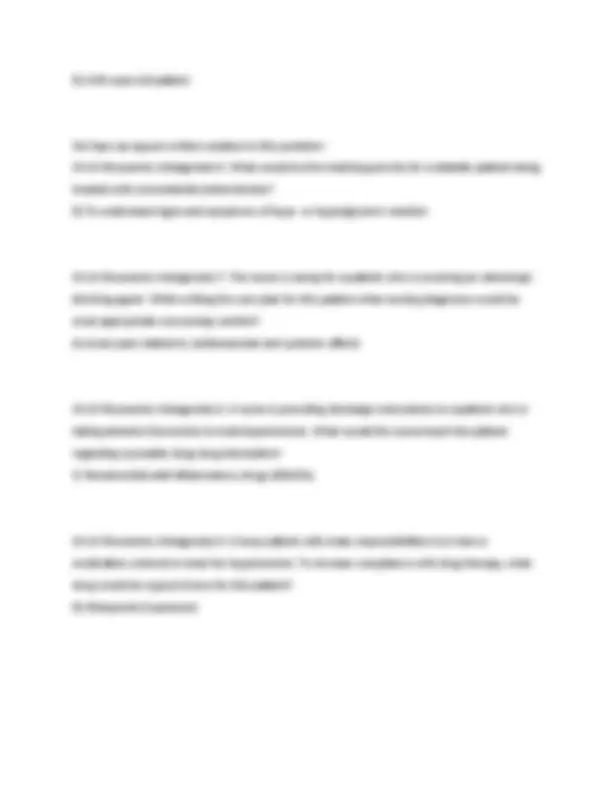
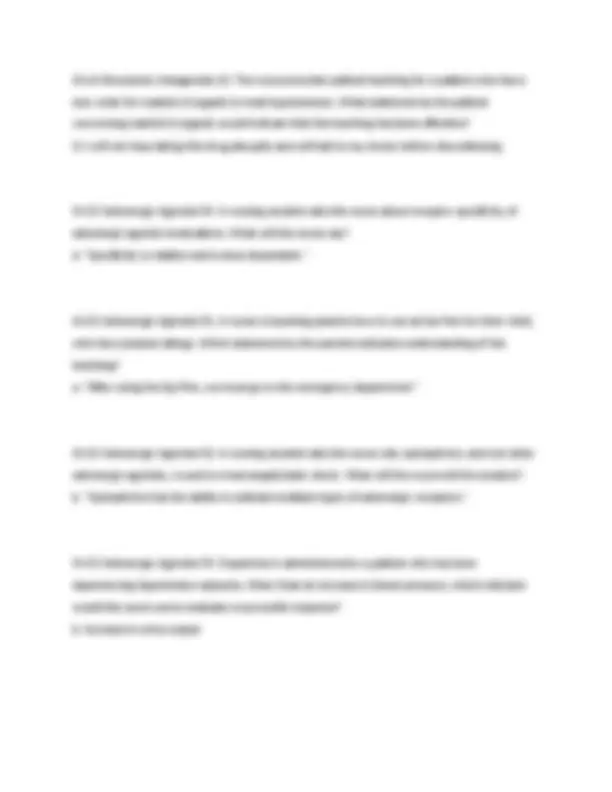
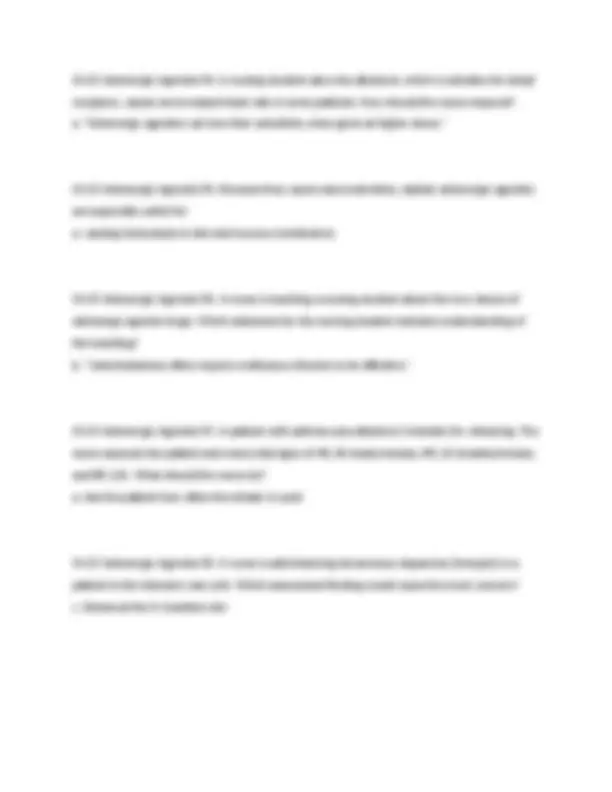
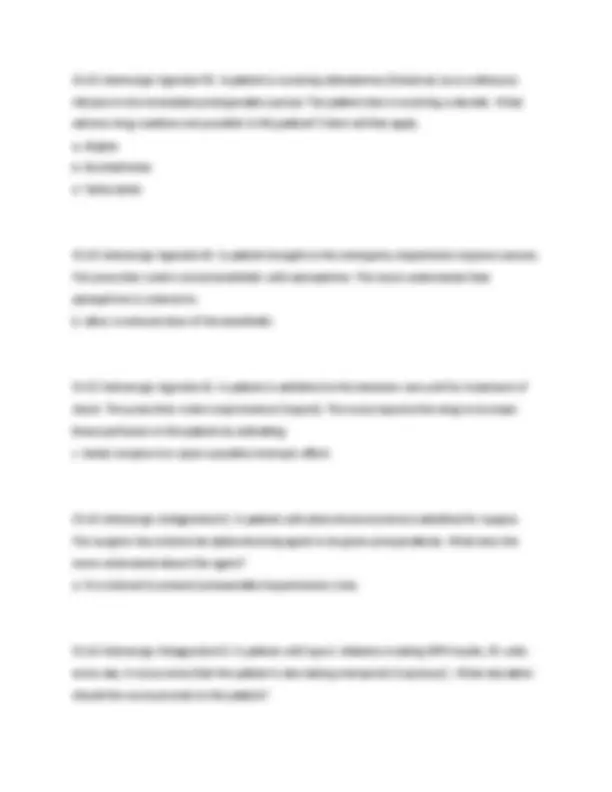
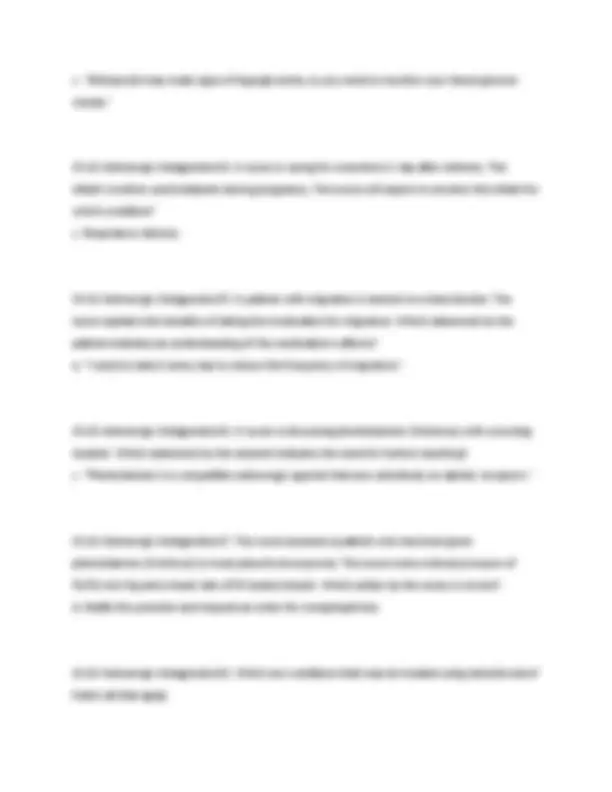
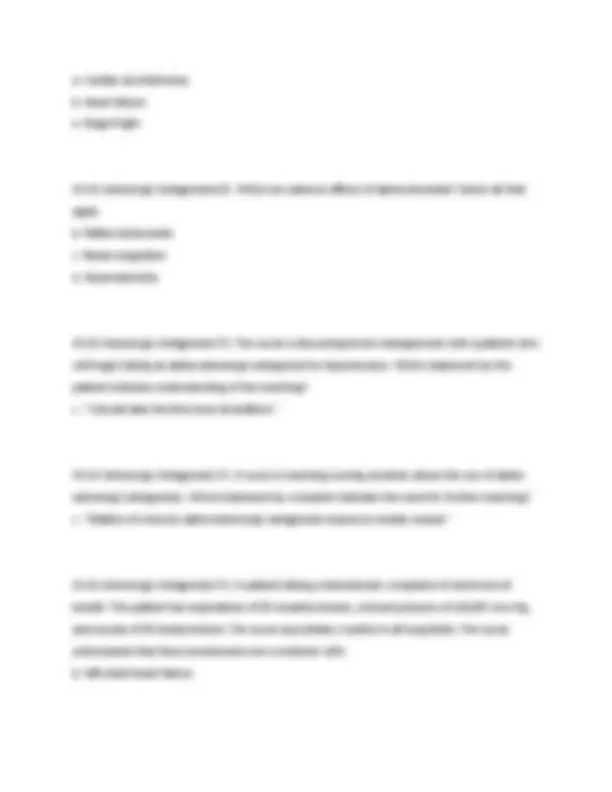
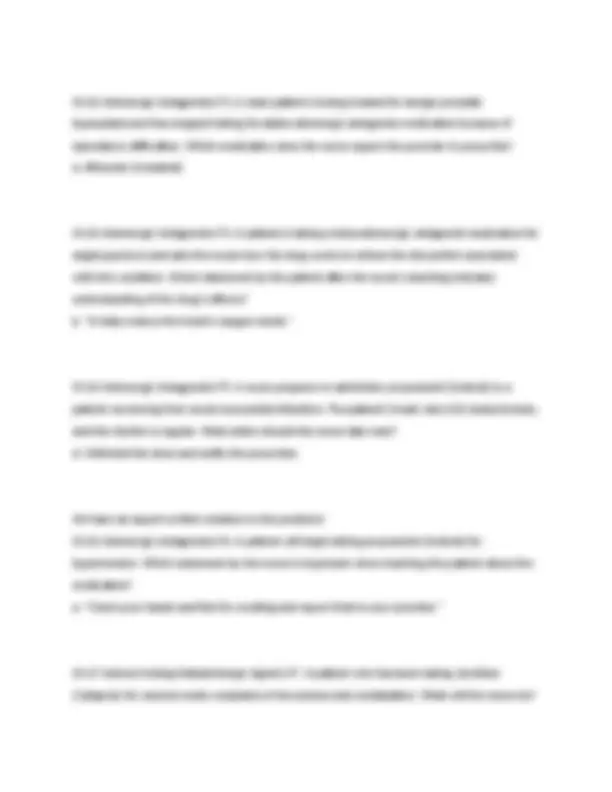
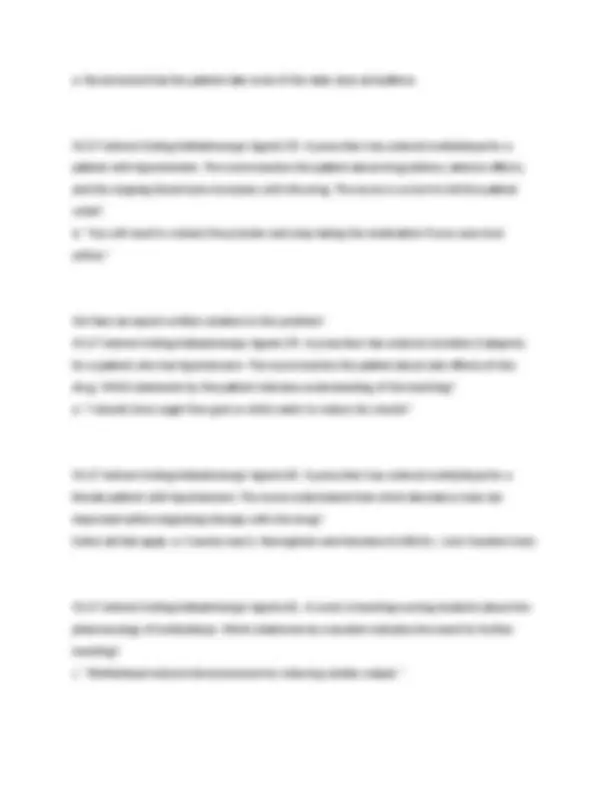
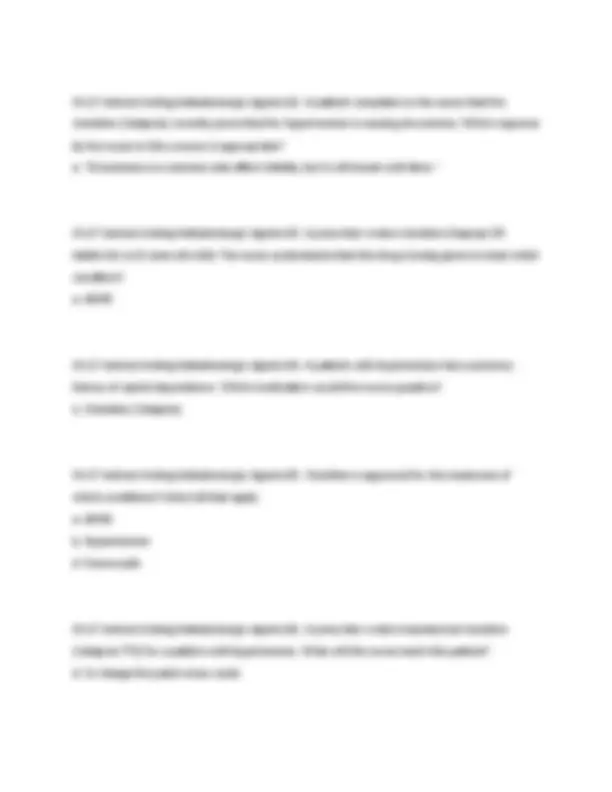
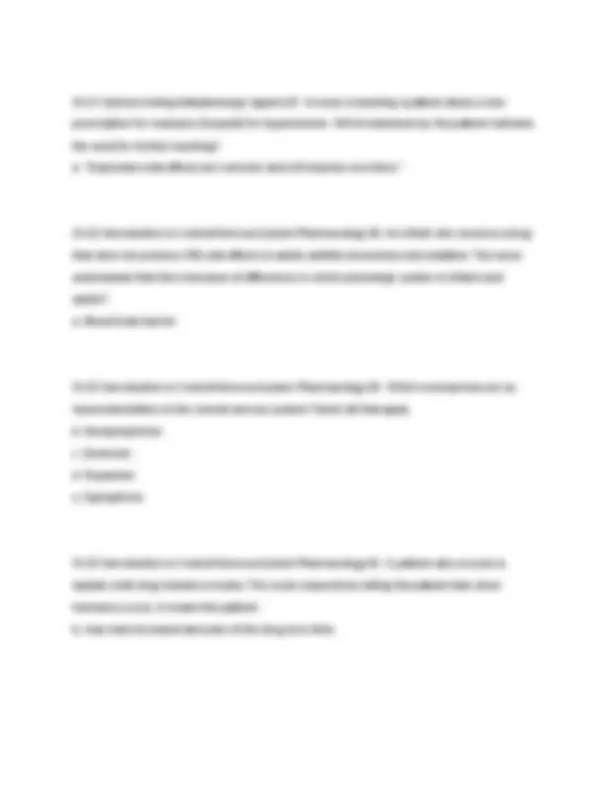
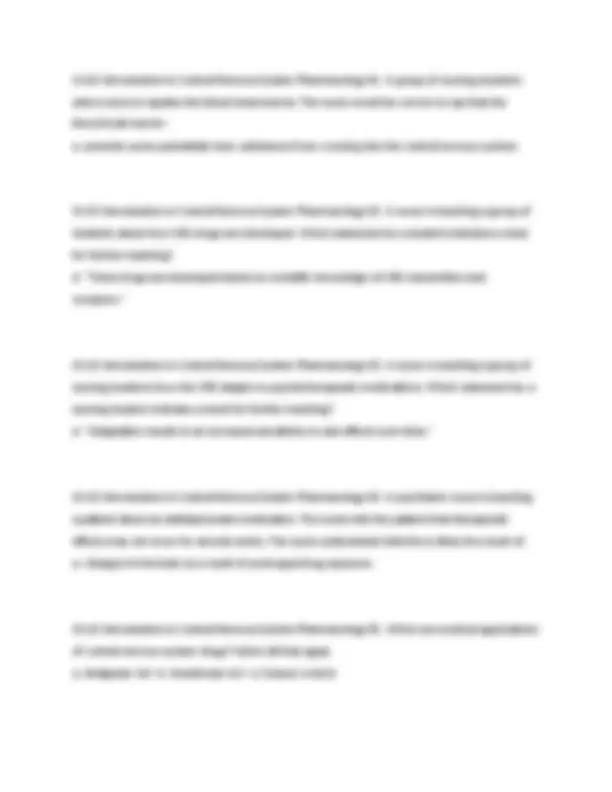
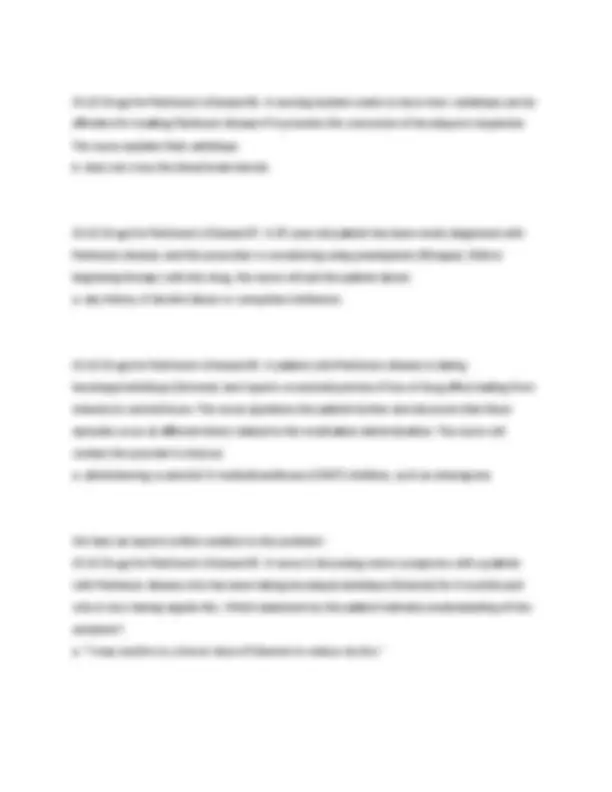
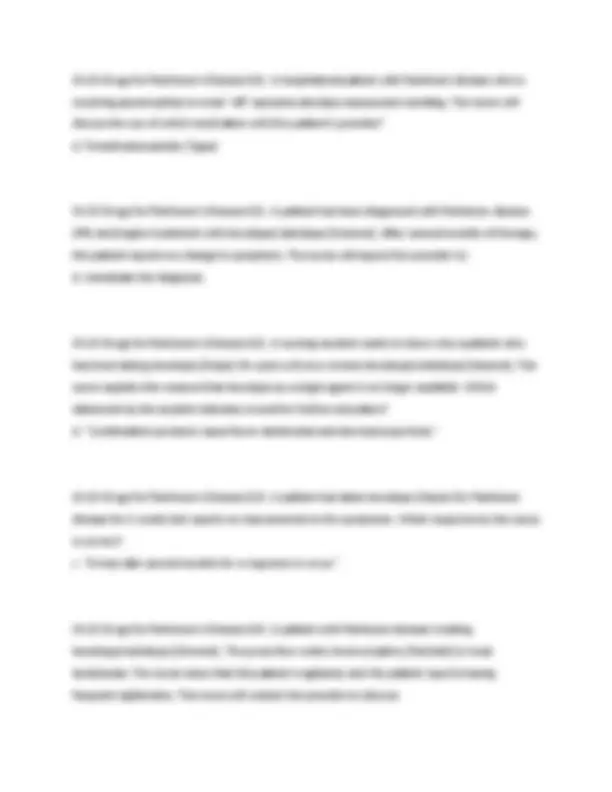
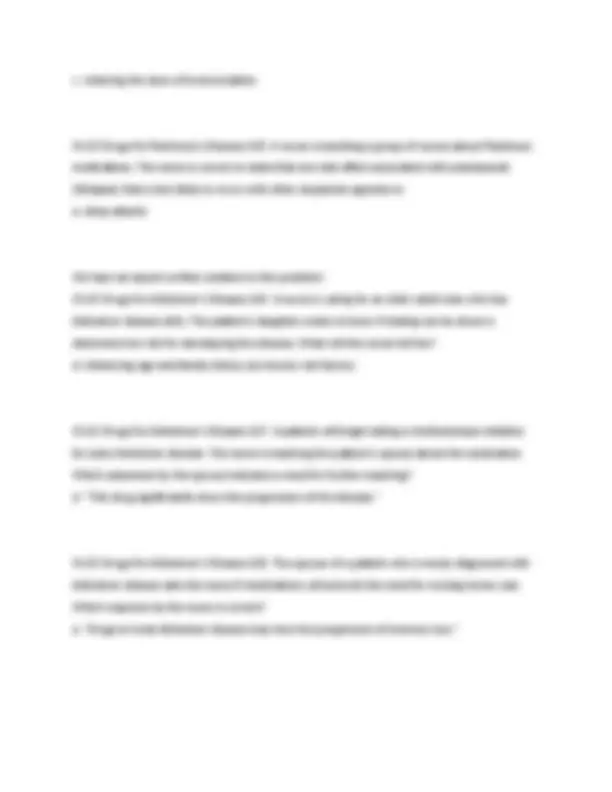
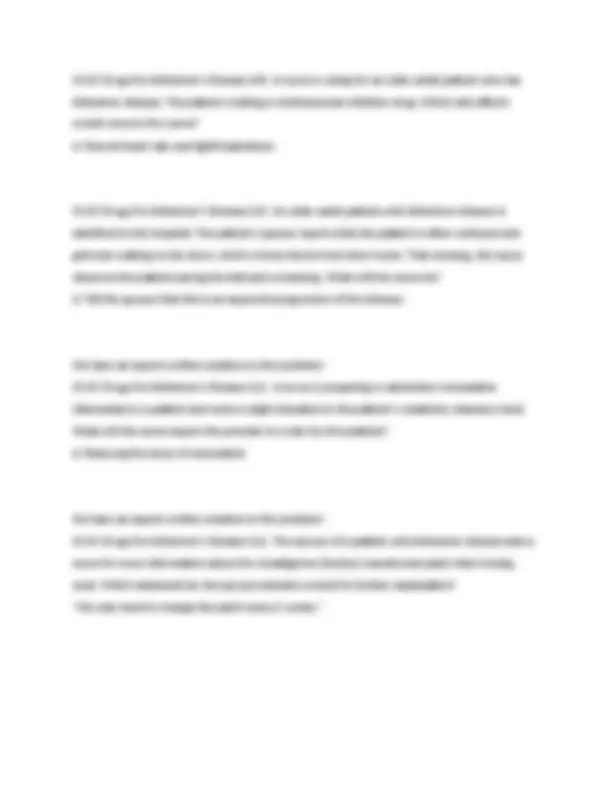
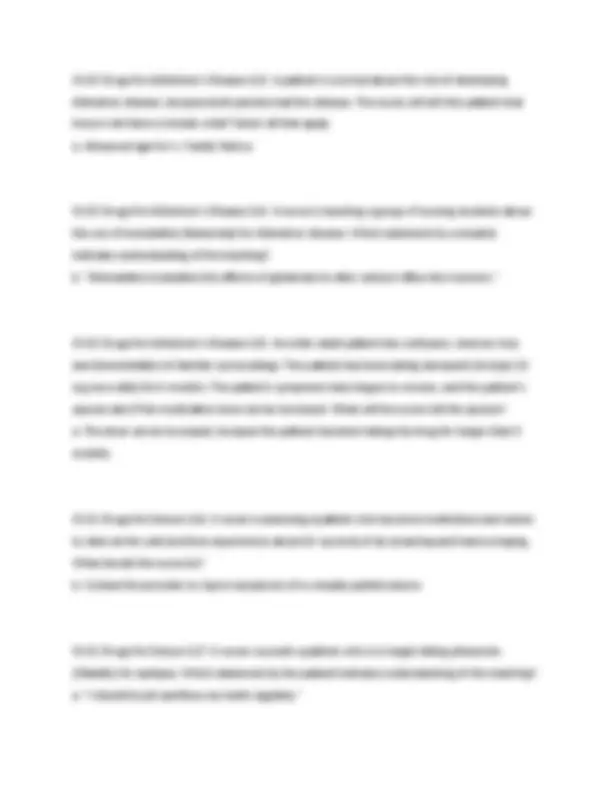
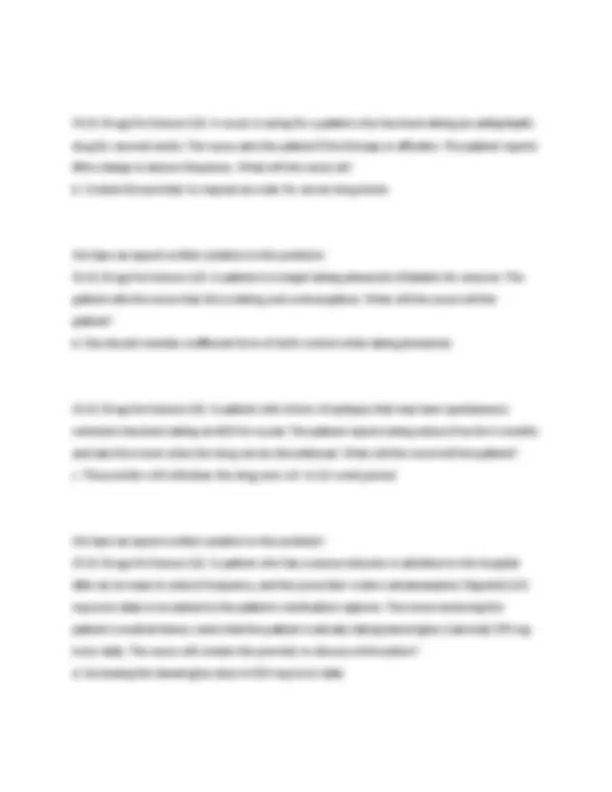
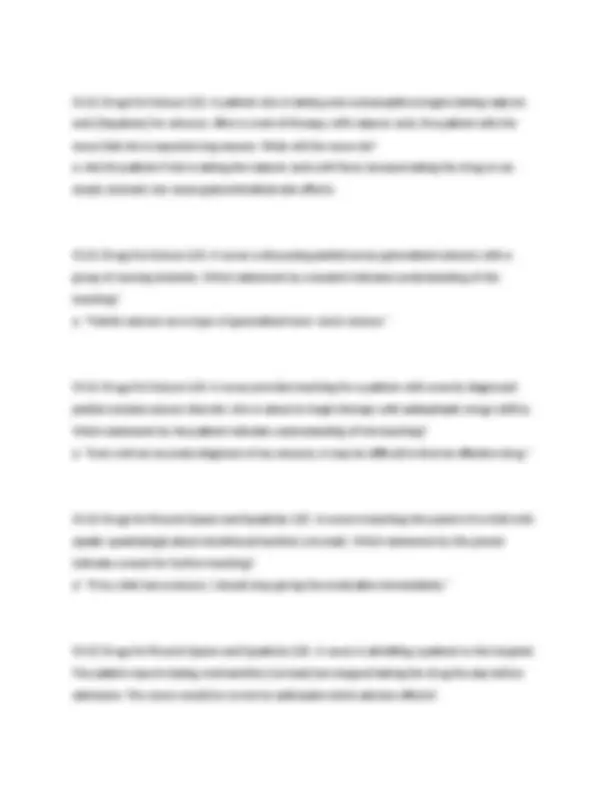
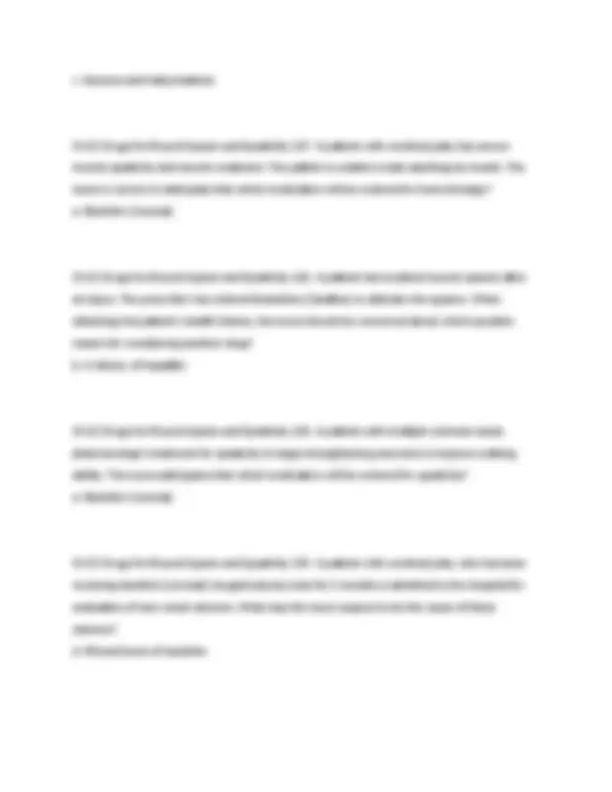
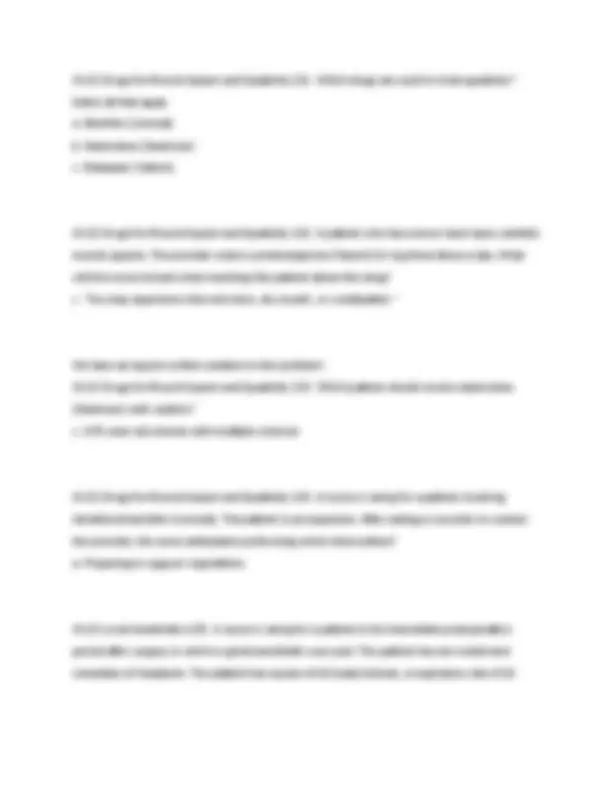
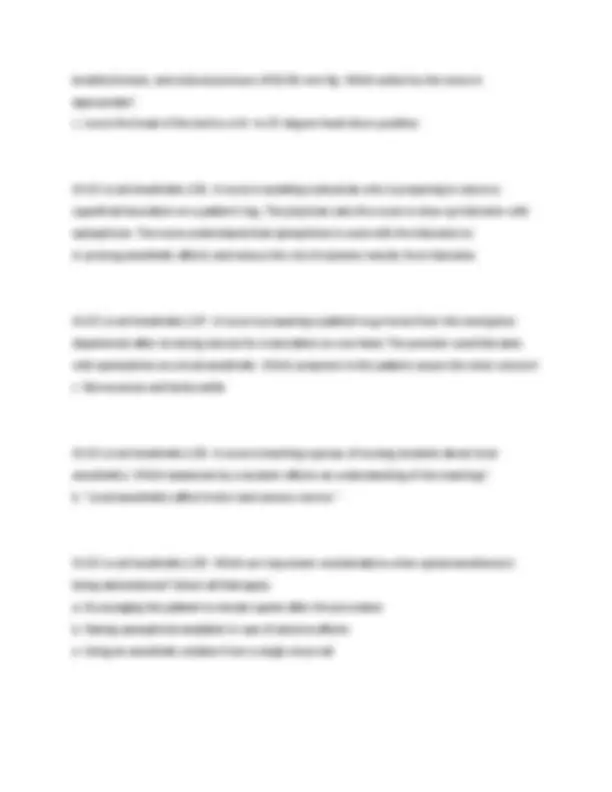
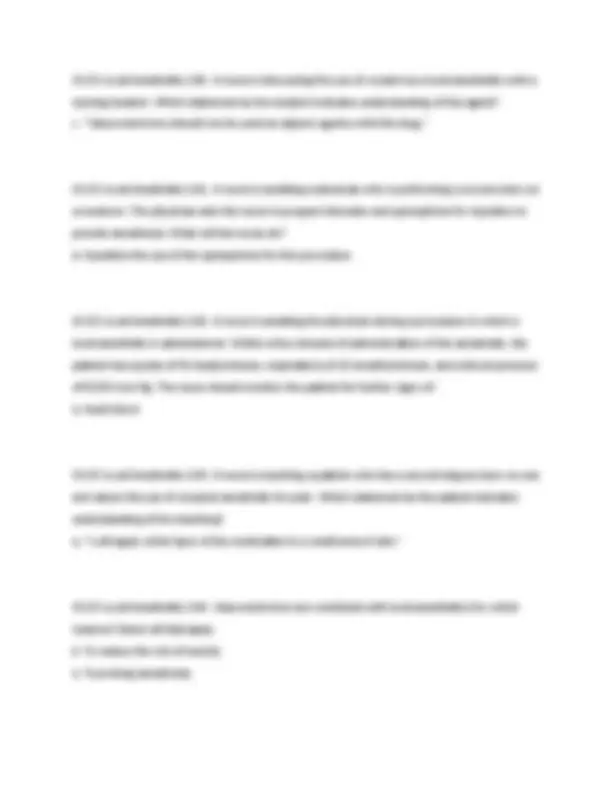
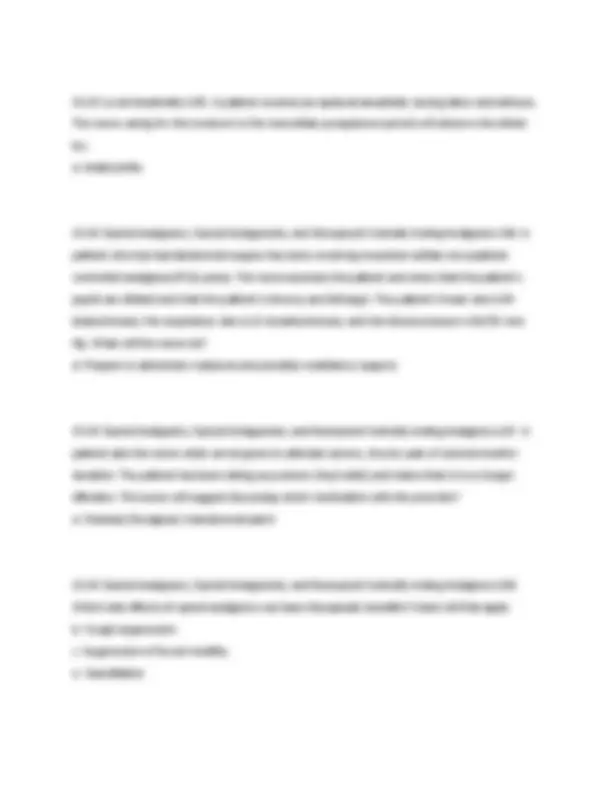
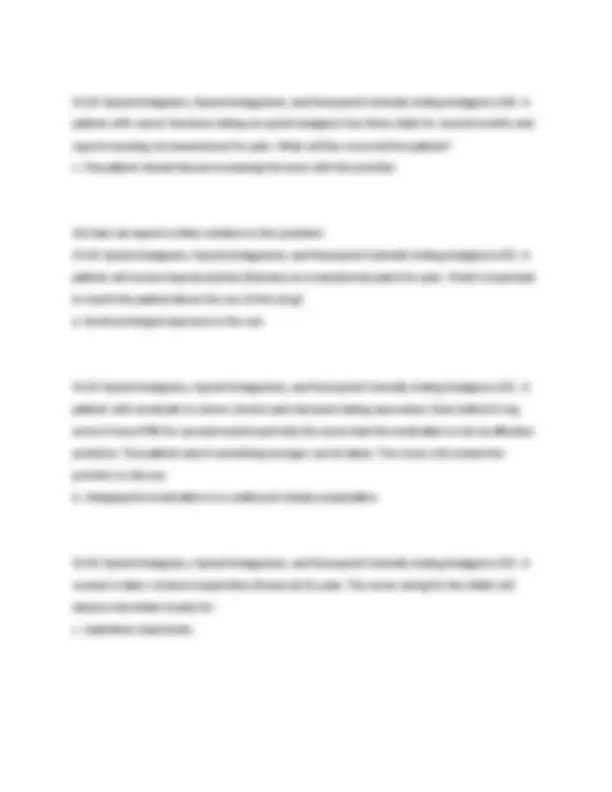
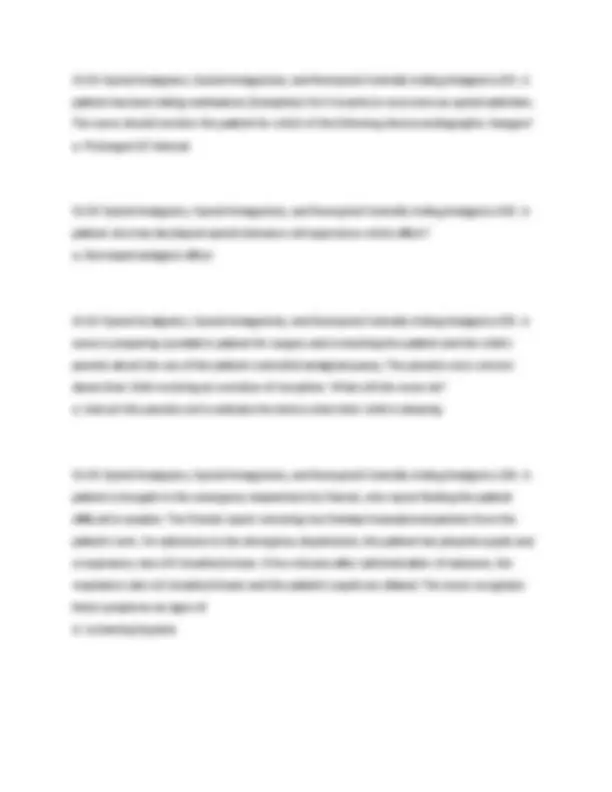
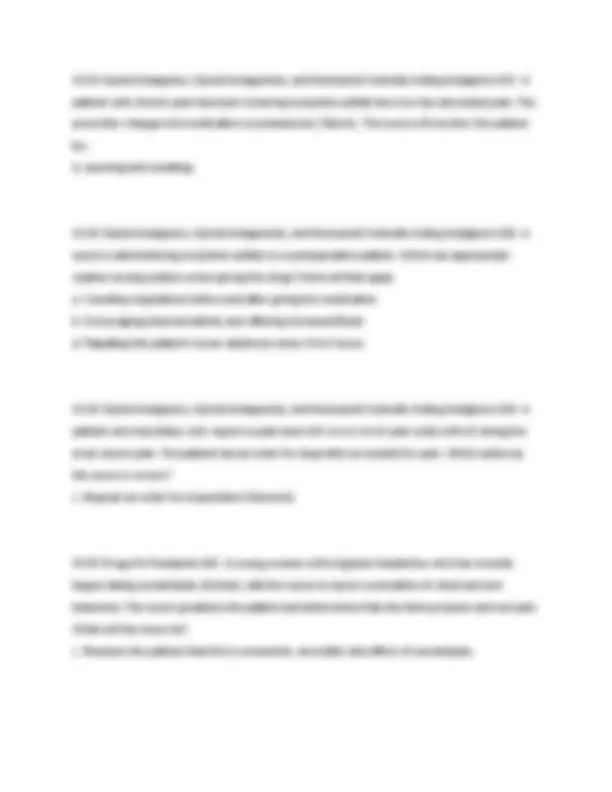
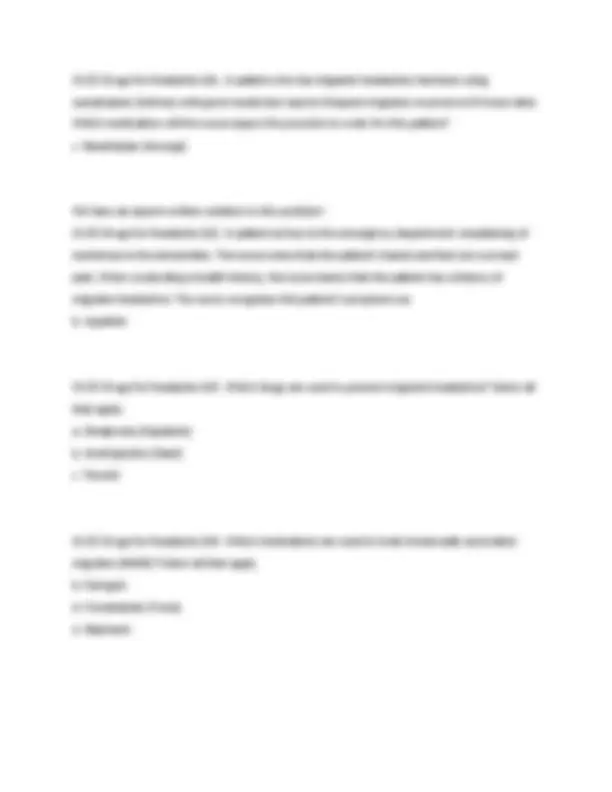
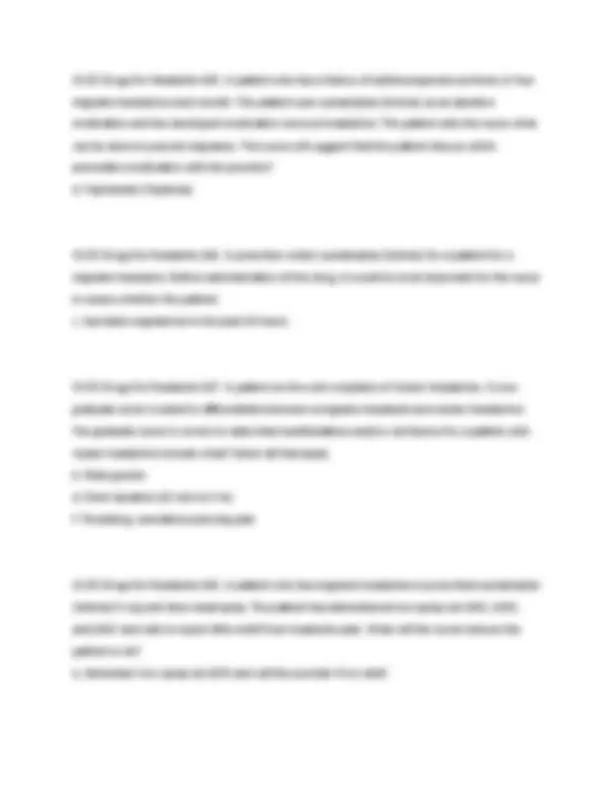
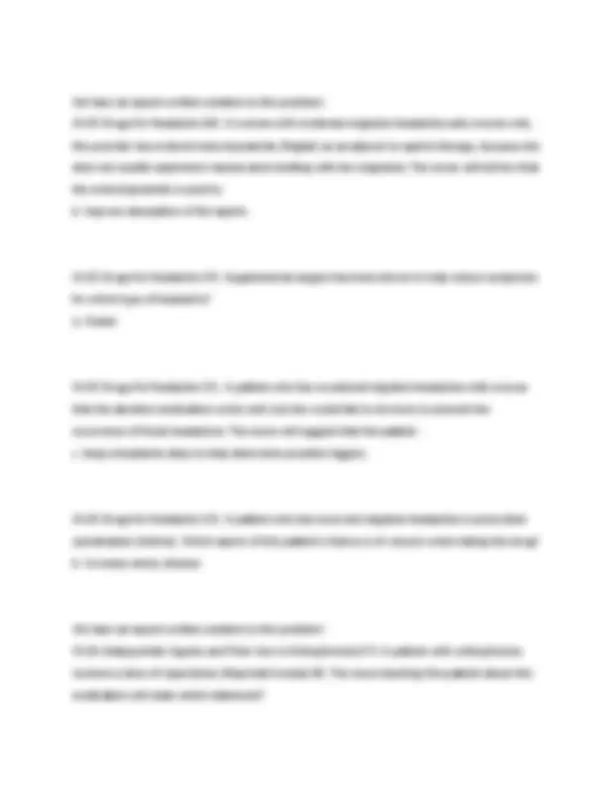
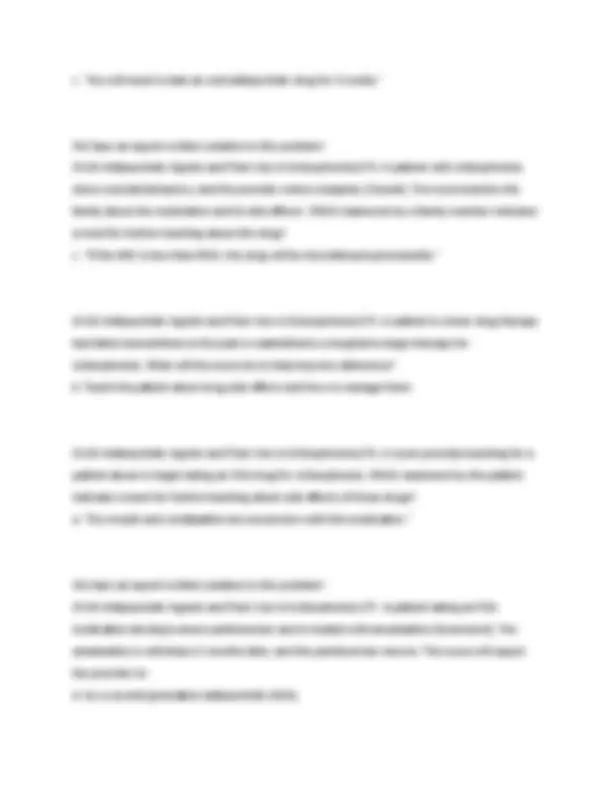
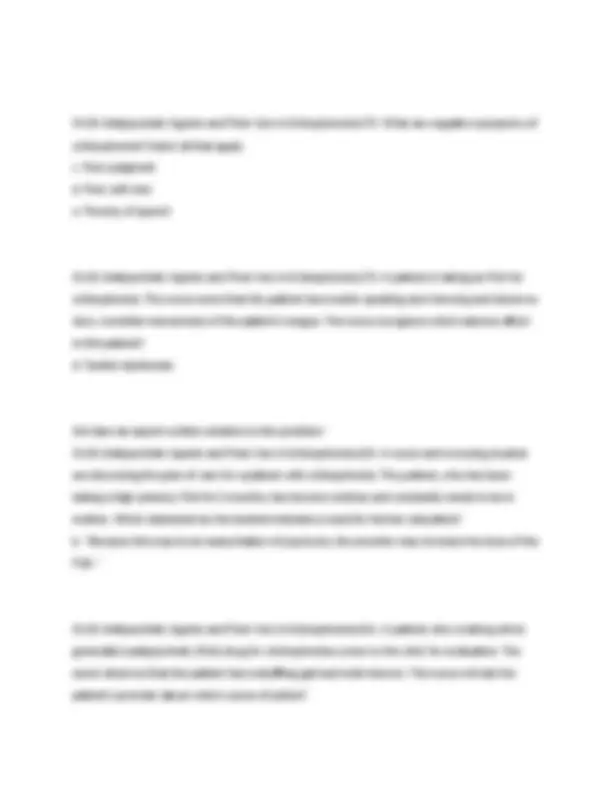
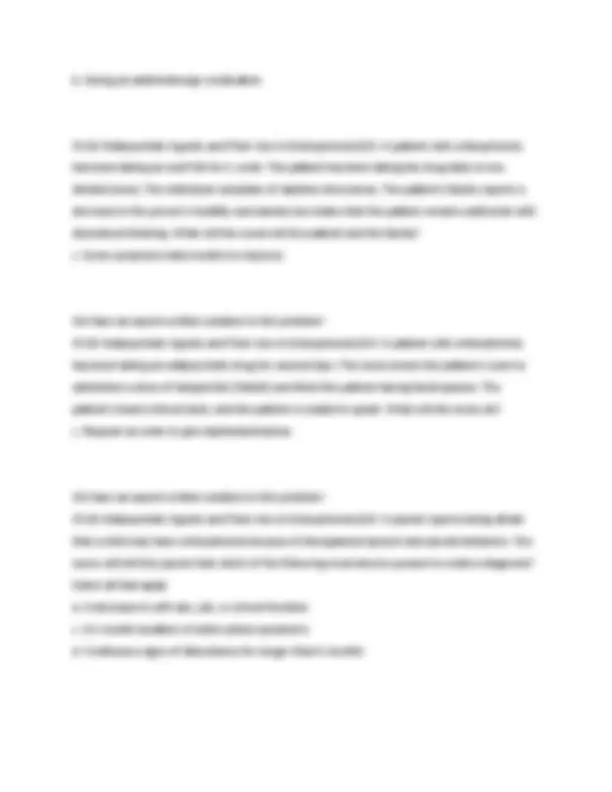
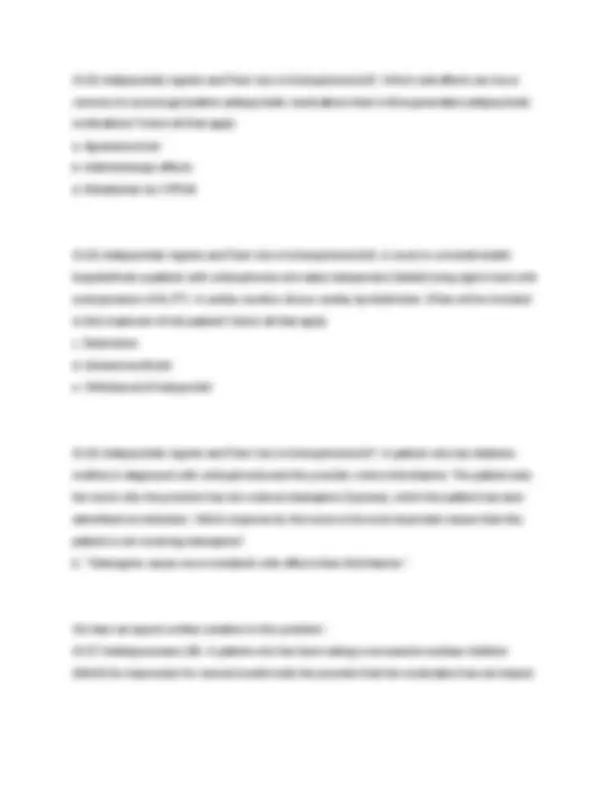
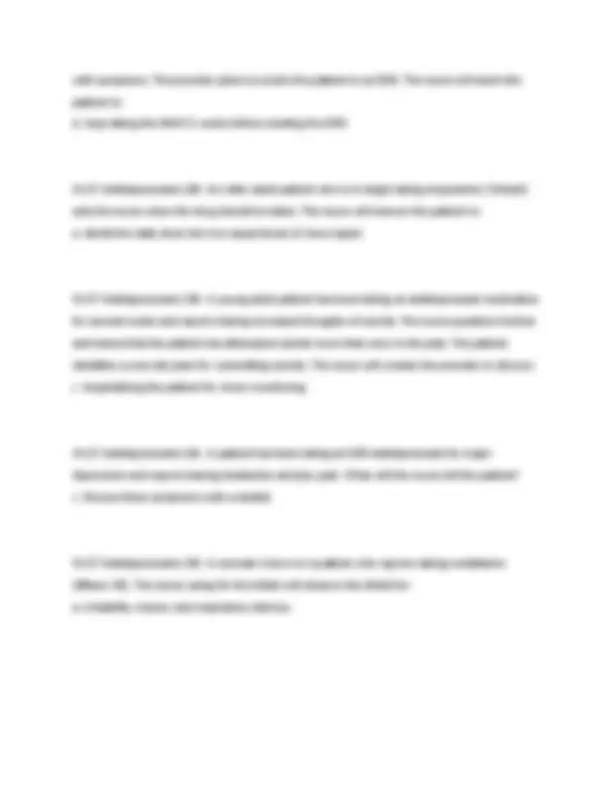
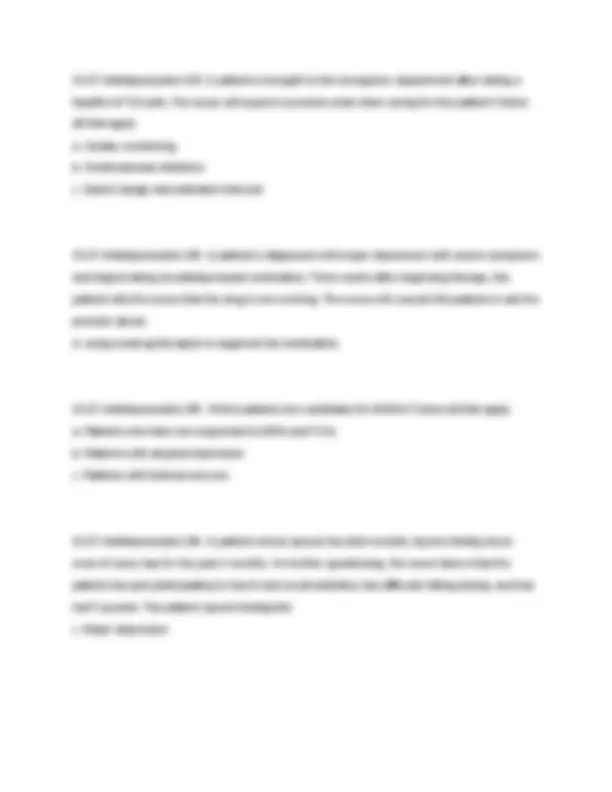
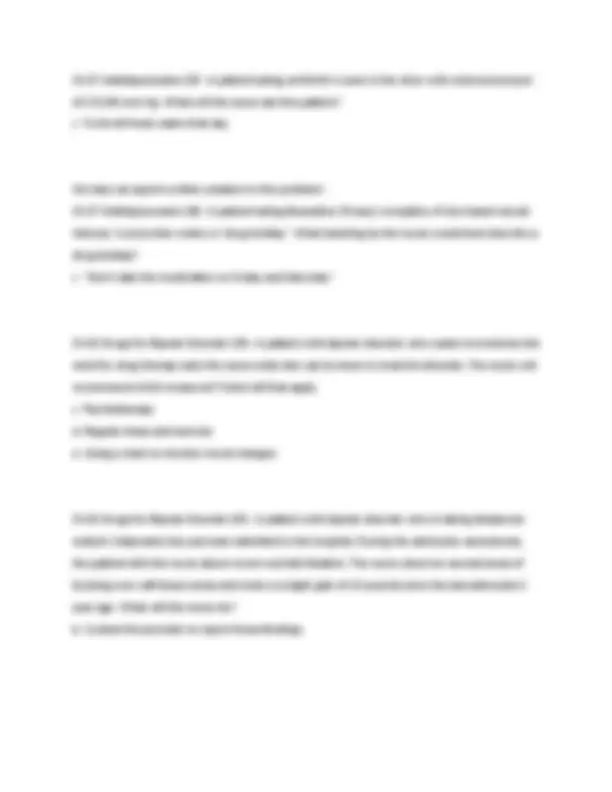
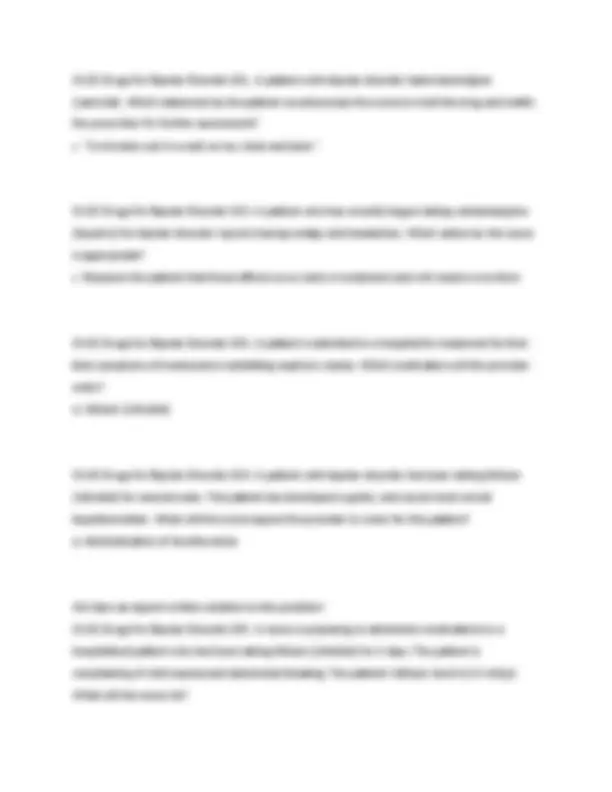
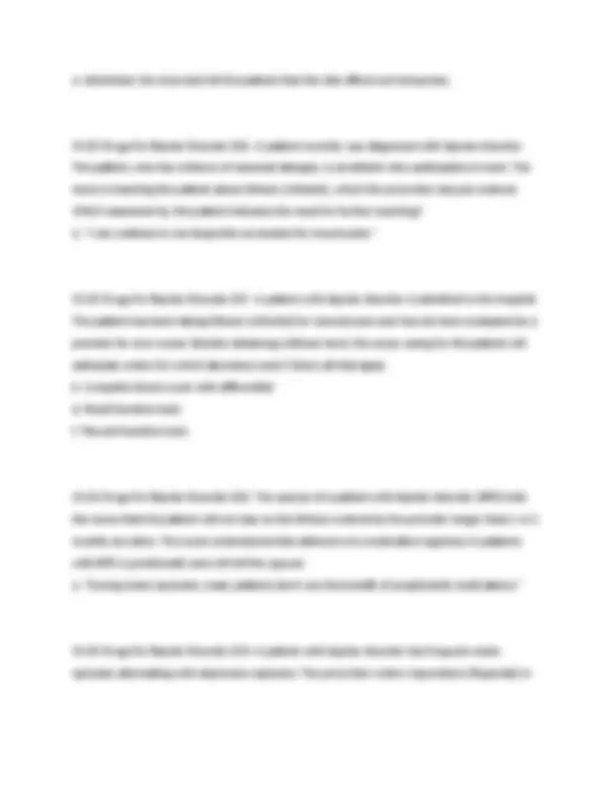
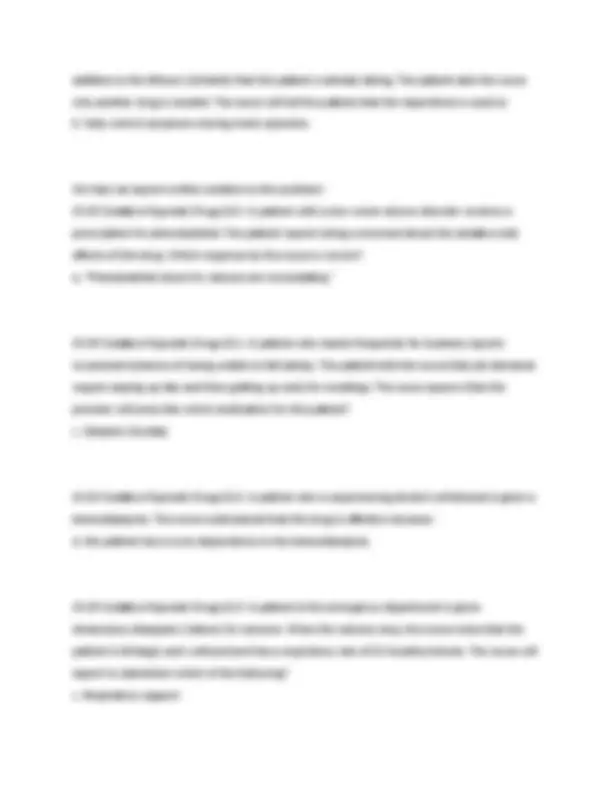
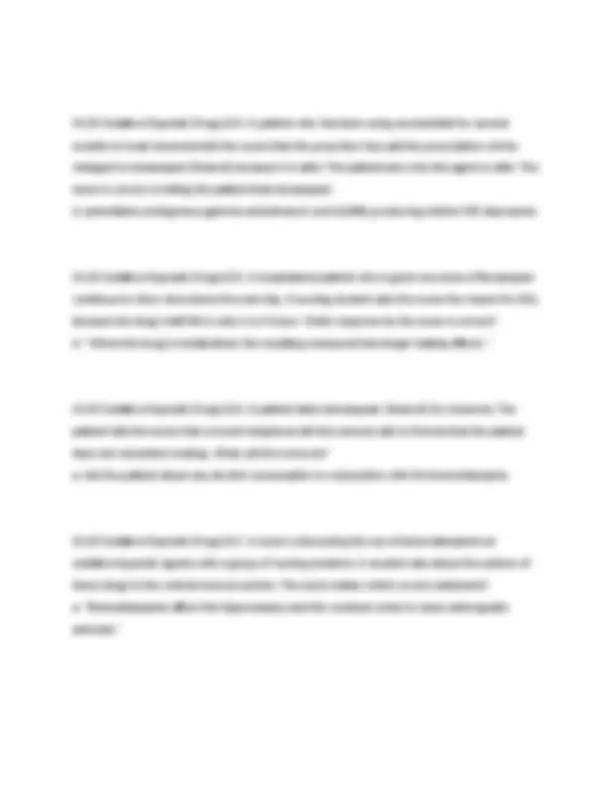
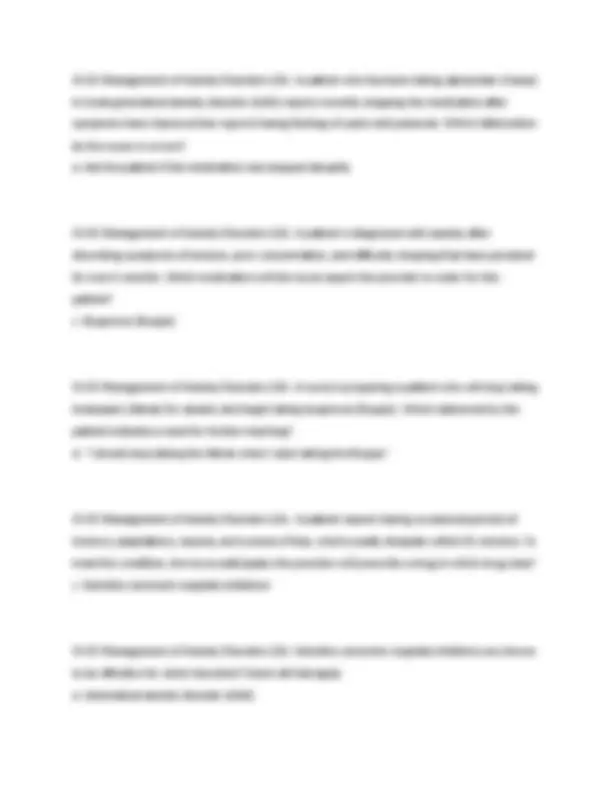
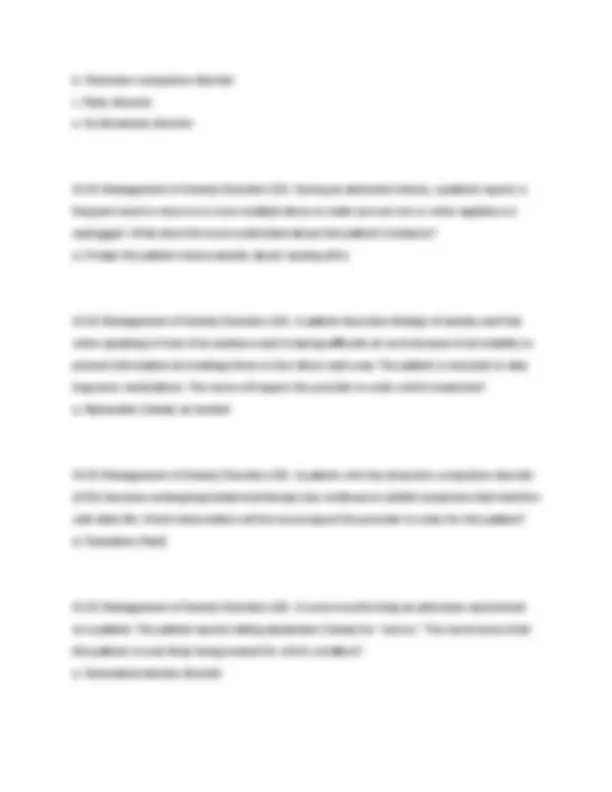
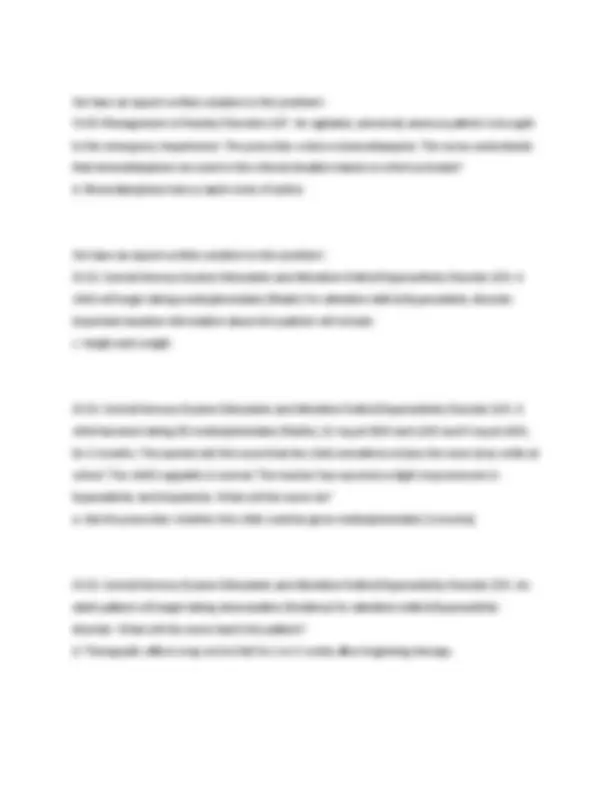
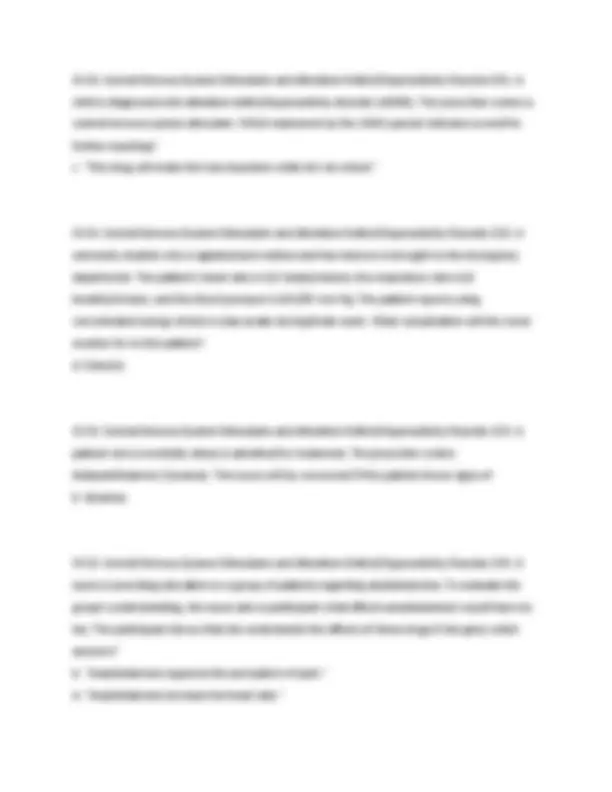
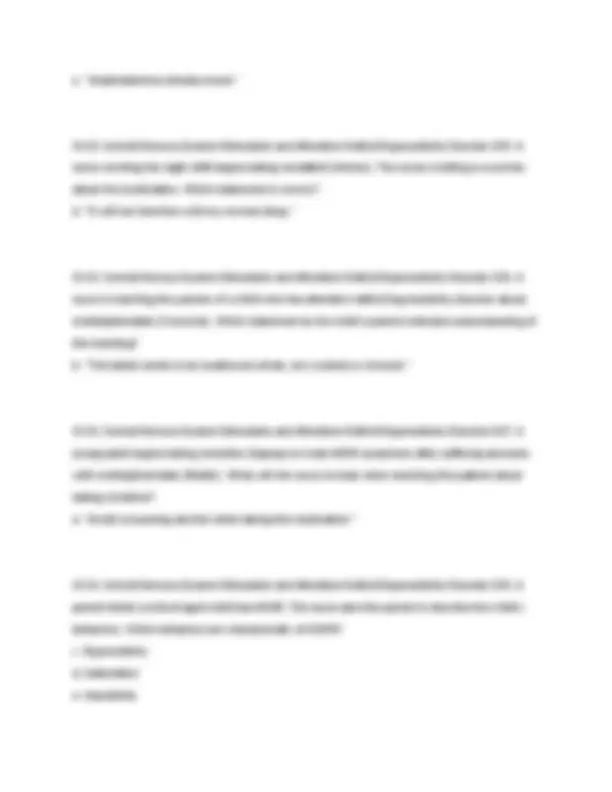
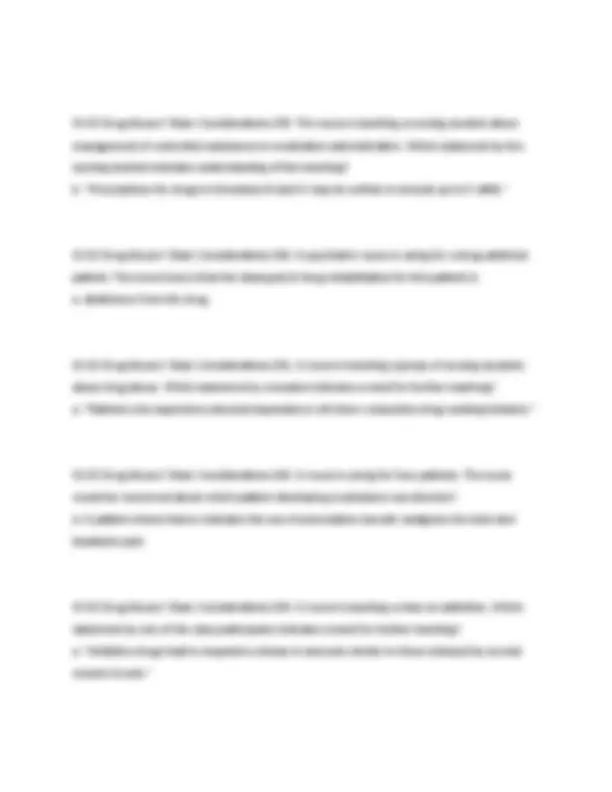
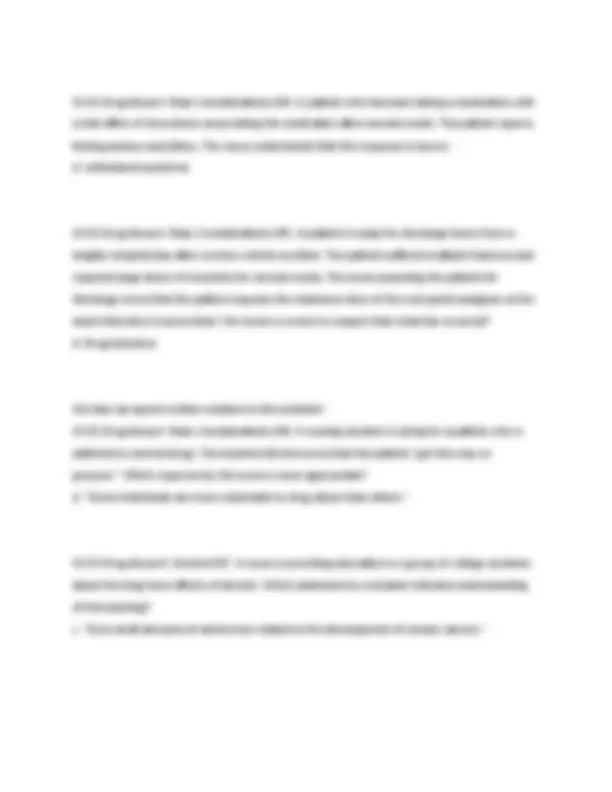
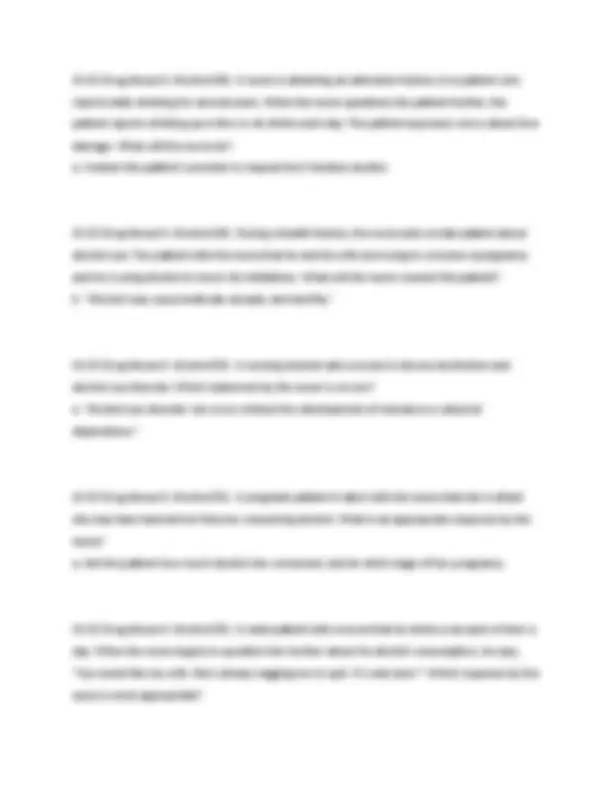
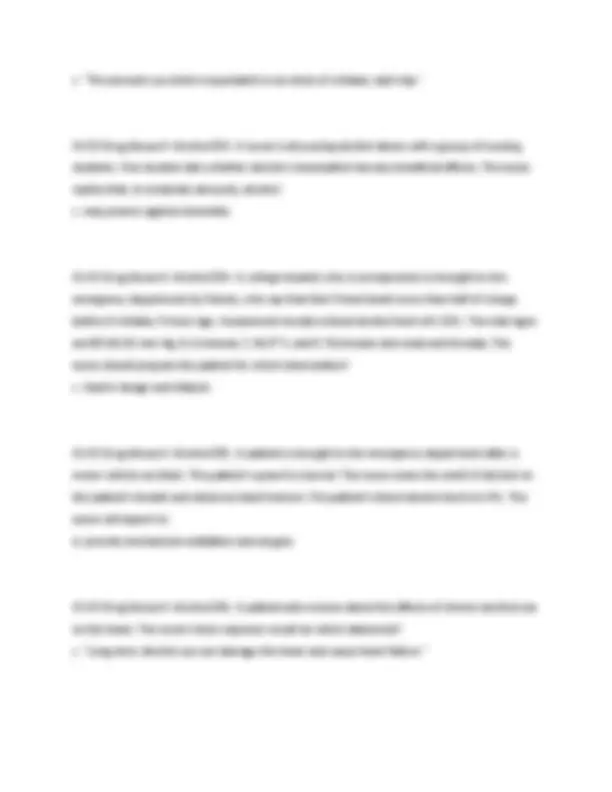
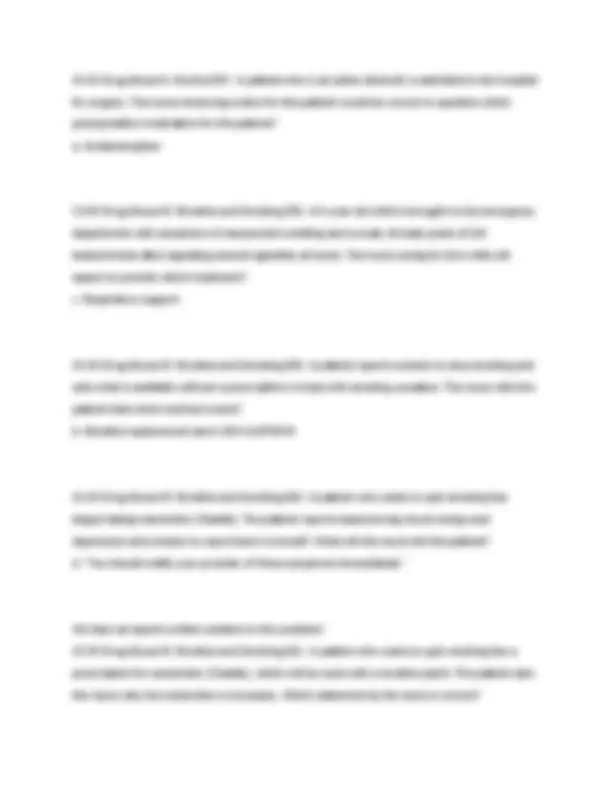
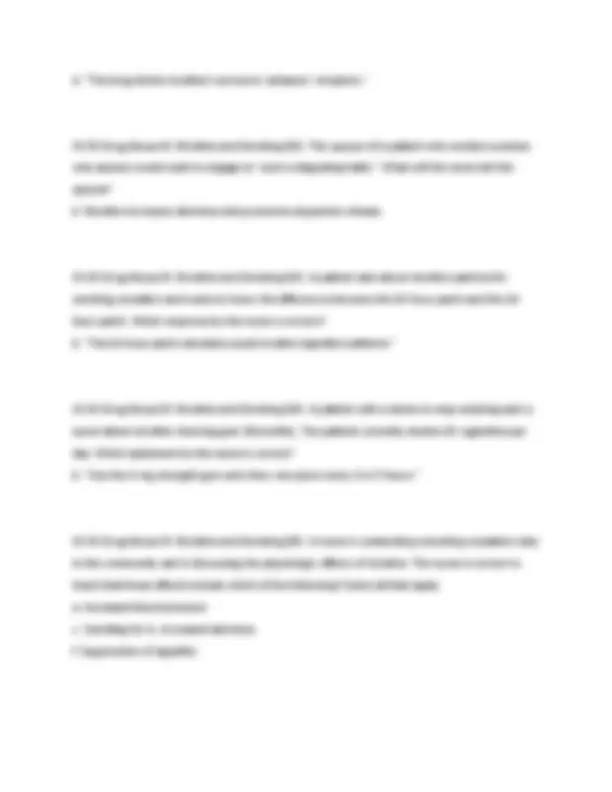
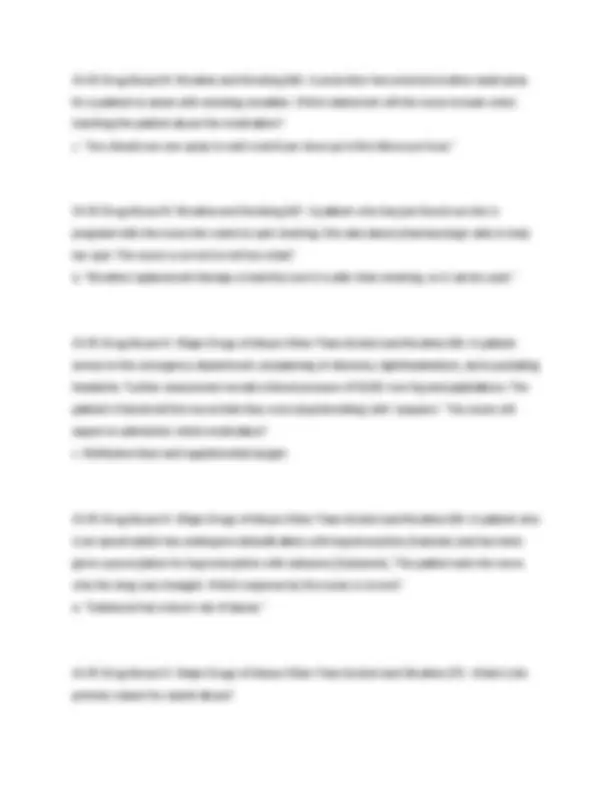
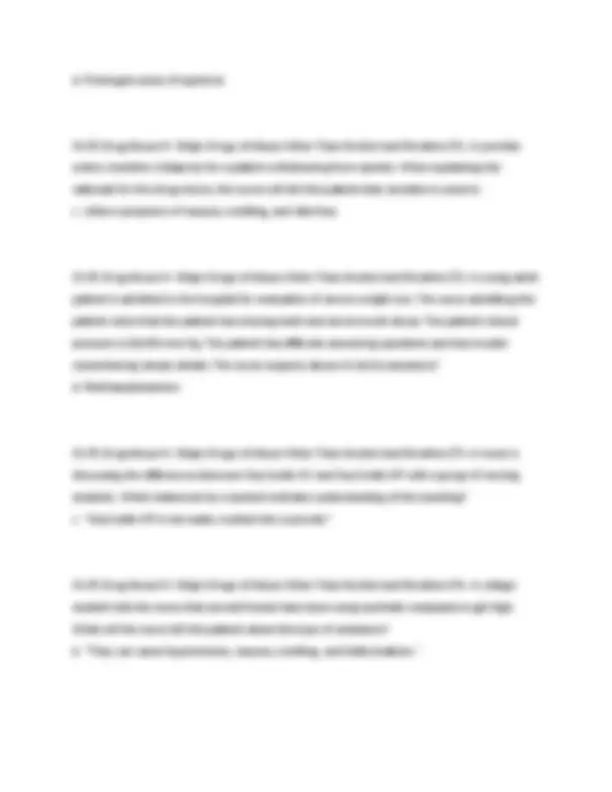
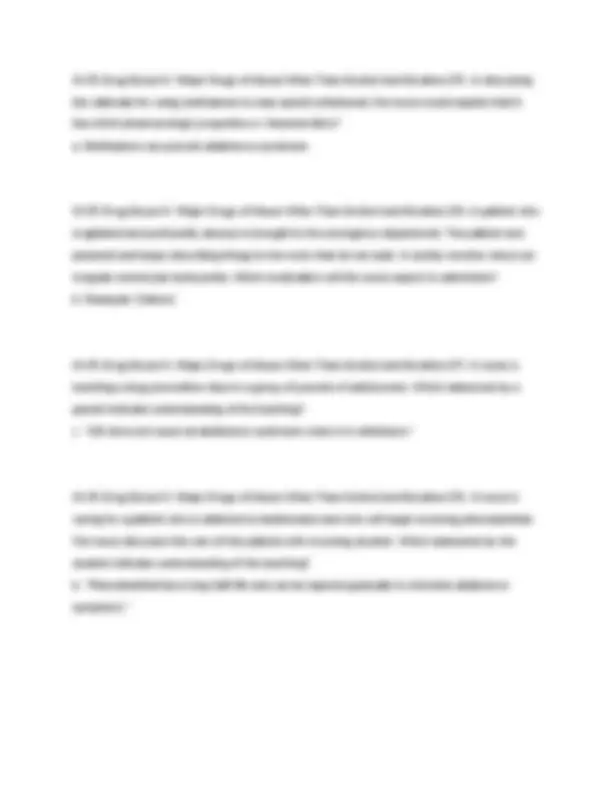
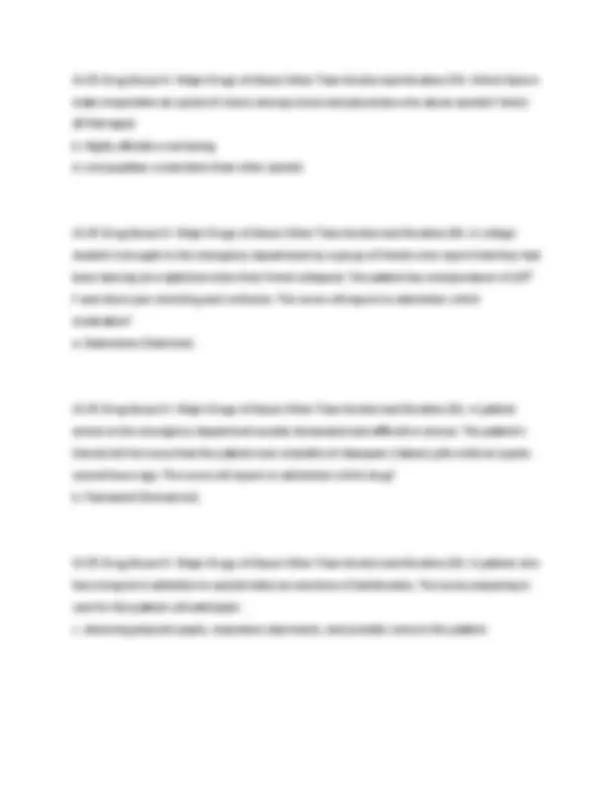
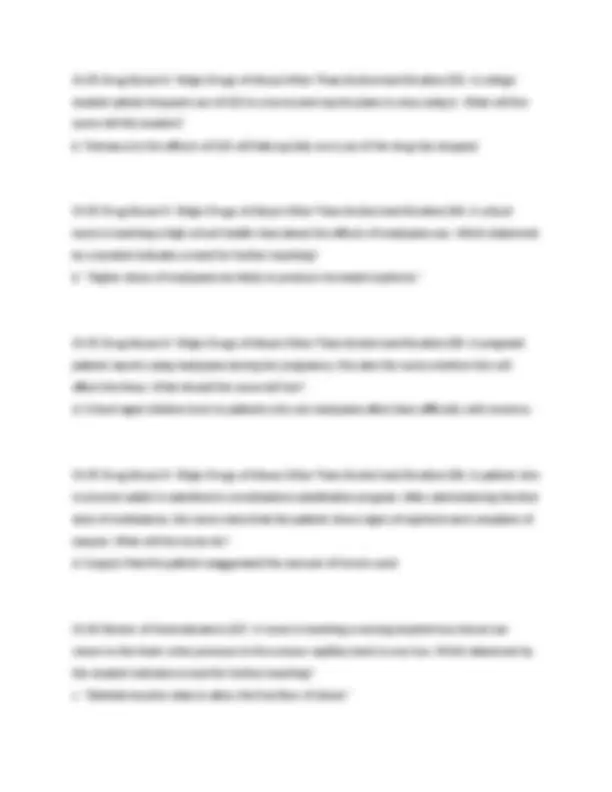
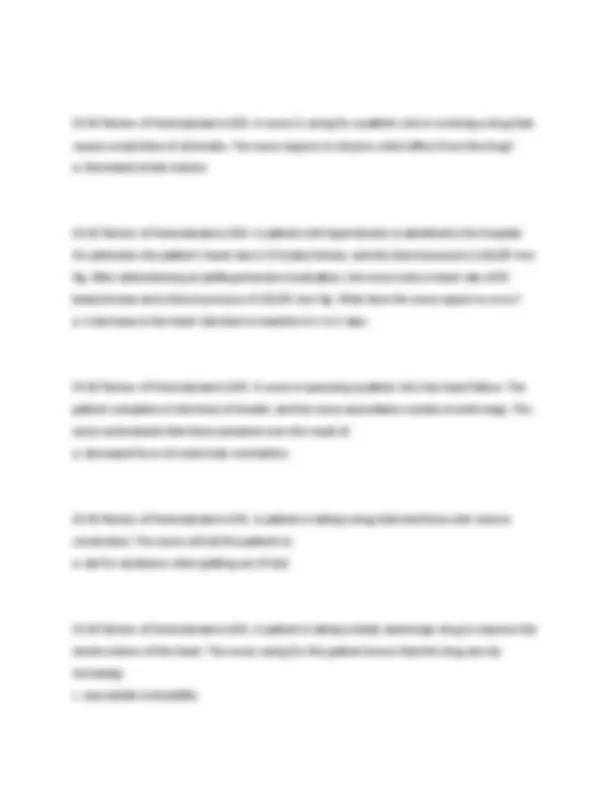
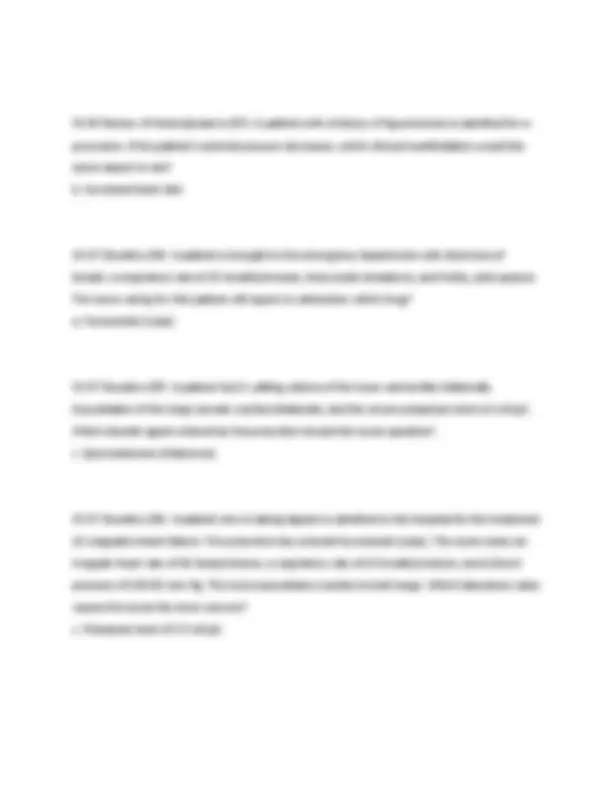
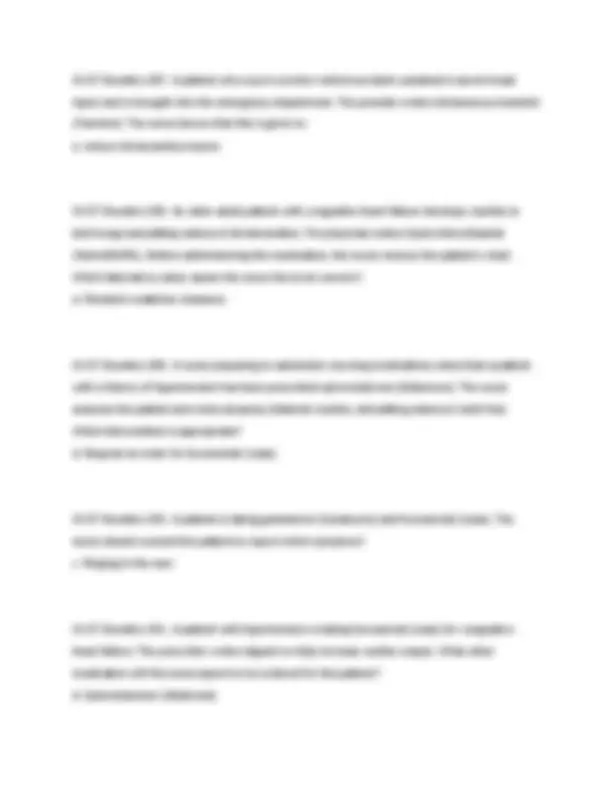
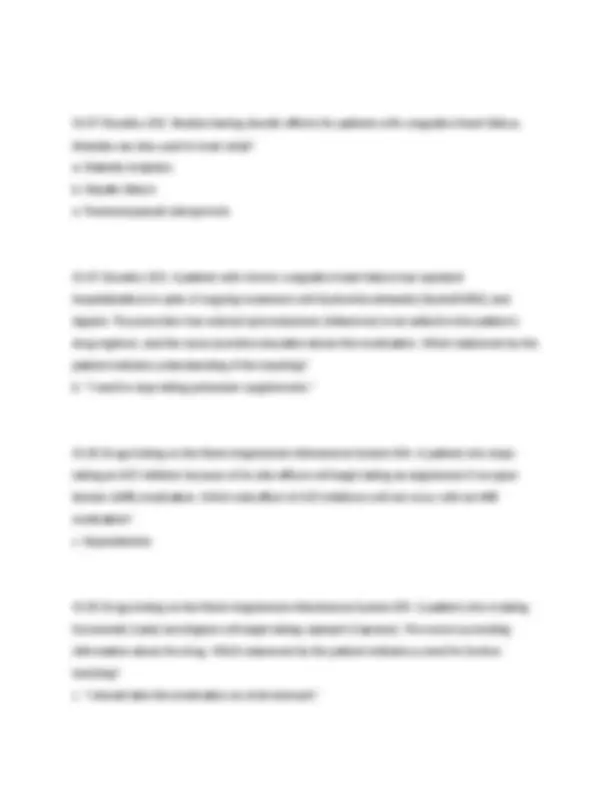
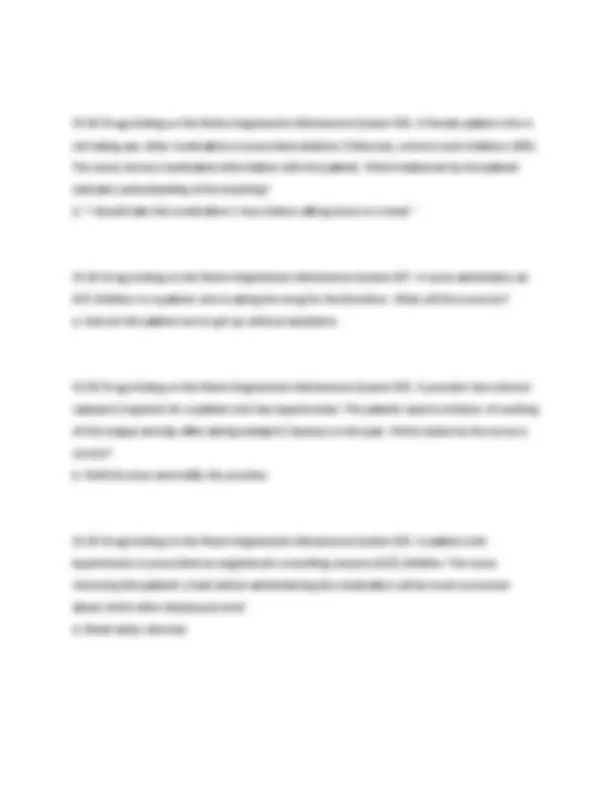
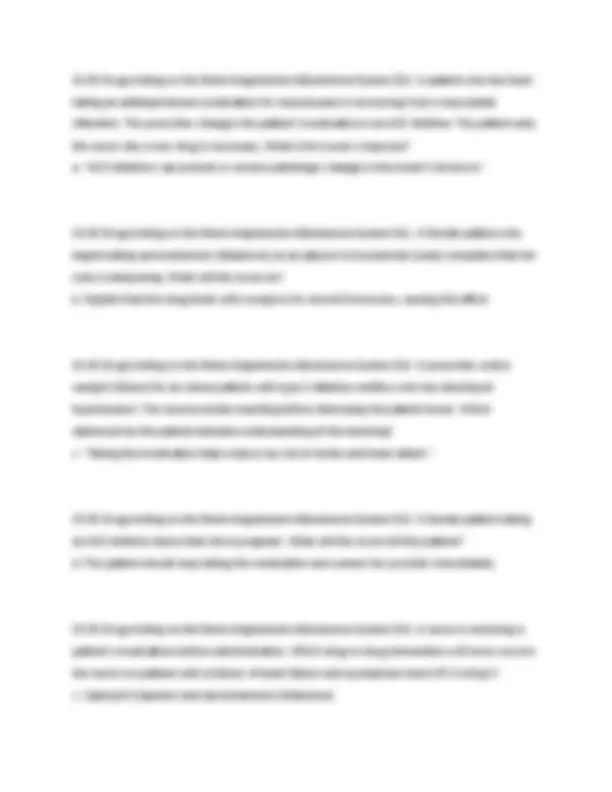
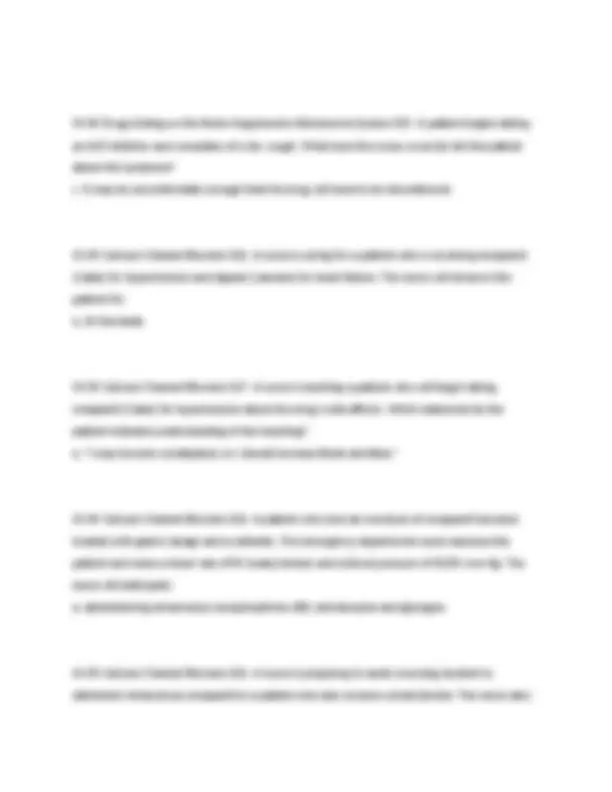
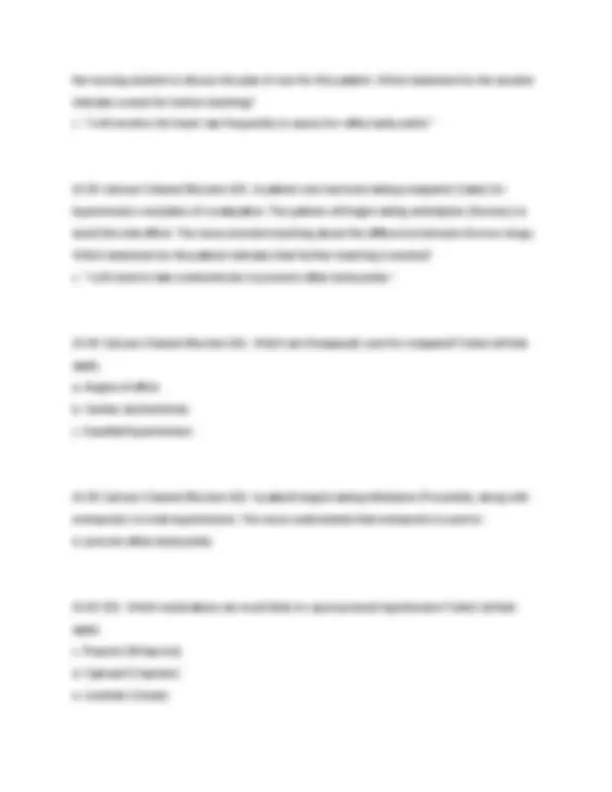
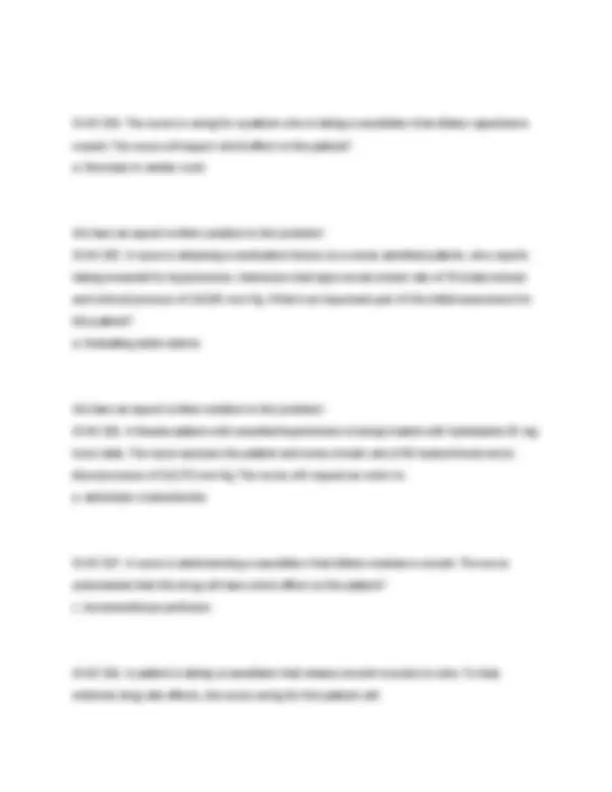
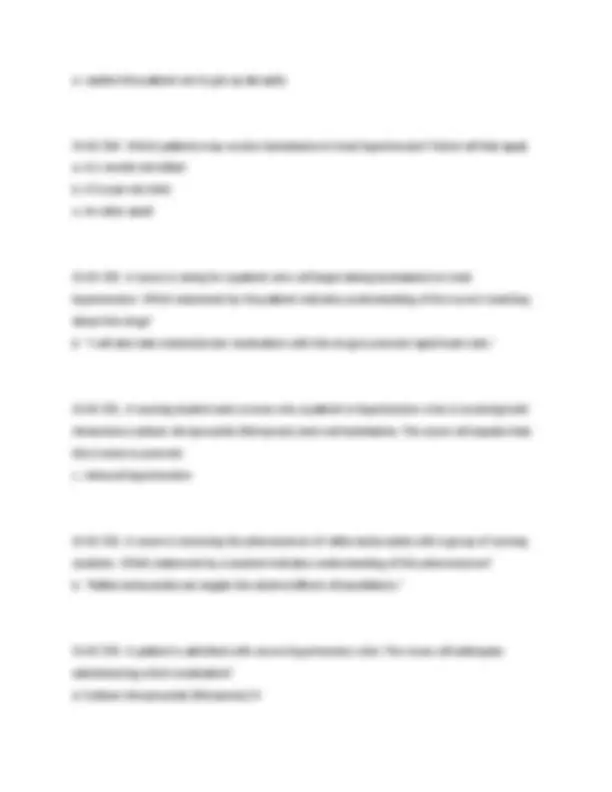
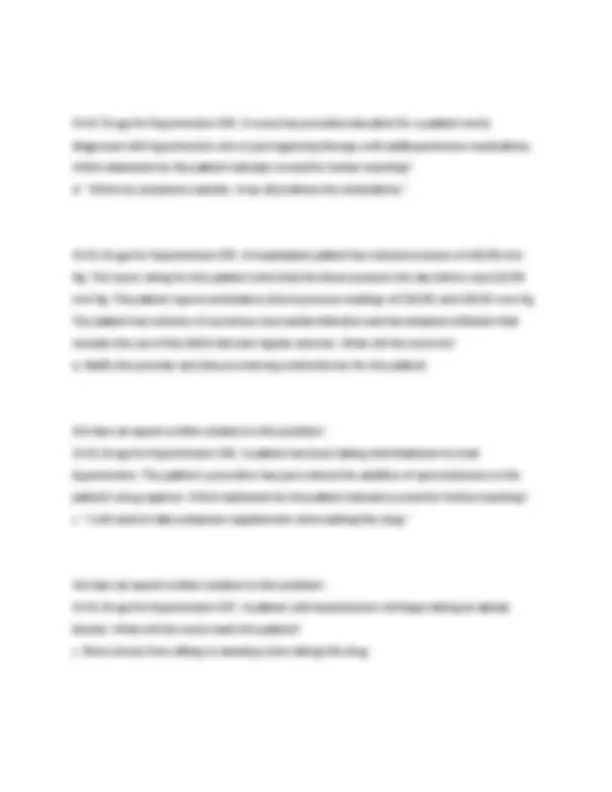
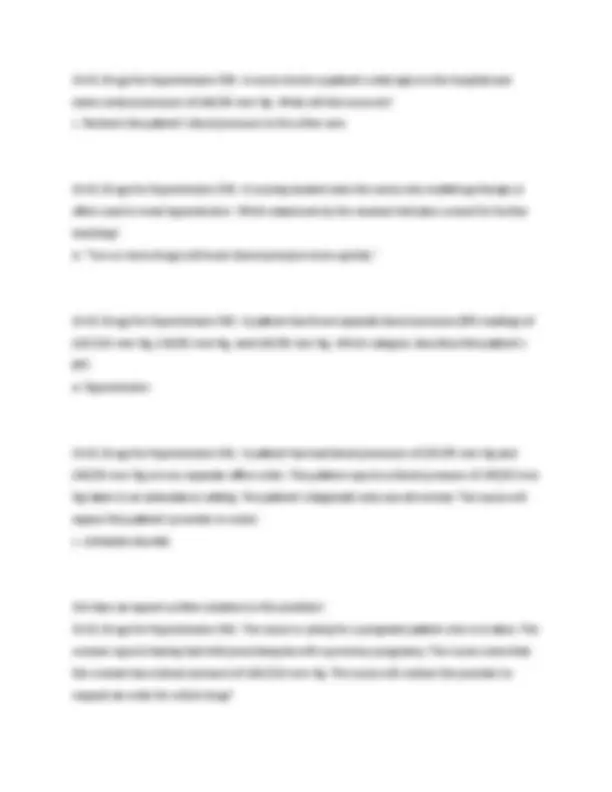
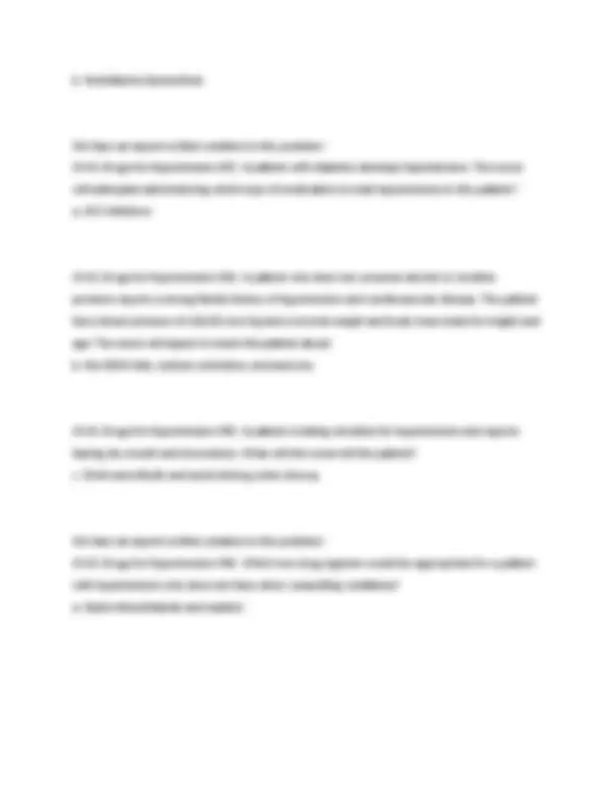
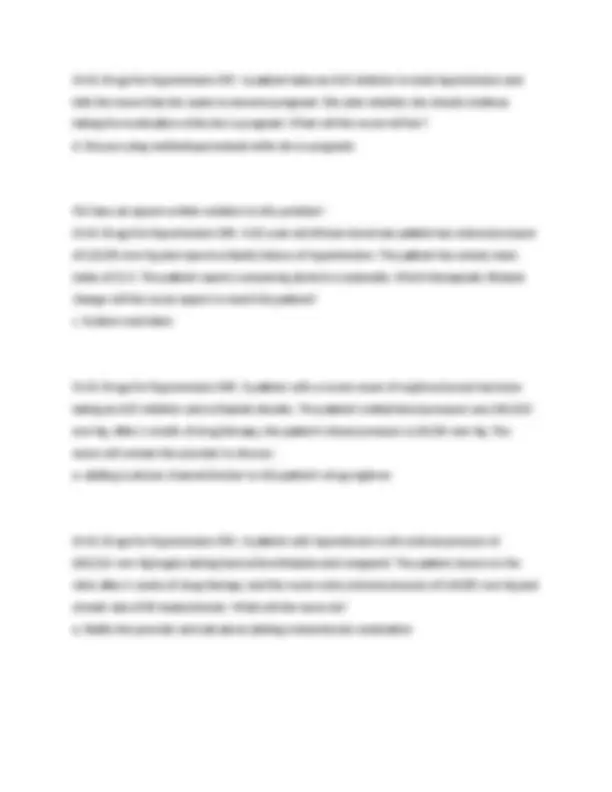
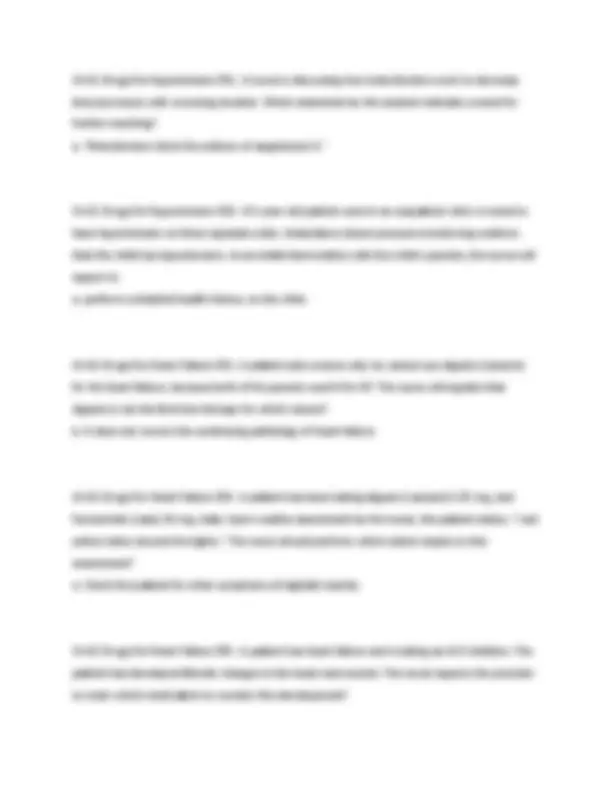


Study with the several resources on Docsity

Earn points by helping other students or get them with a premium plan


Prepare for your exams
Study with the several resources on Docsity

Earn points to download
Earn points by helping other students or get them with a premium plan
Community
Ask the community for help and clear up your study doubts
Discover the best universities in your country according to Docsity users
Free resources
Download our free guides on studying techniques, anxiety management strategies, and thesis advice from Docsity tutors
Lehne’s Pharmacotherapeutics for Advanced Practice Nurses and Physician Assistants (2nd Edition Rosenthal Test Bank) Ch 1 Prescriptive Authority 2. Which factors increase the need for APRNs to have full prescriptive authority? a. More patients will have access to health care. Ch 1 Prescriptive Authority 3. Which factors could be attributed to limited prescriptive authority for APRNs? Select all that apply. a. Inaccessibility of patient care b. Higher health care costs
Typology: Exams
1 / 206

This page cannot be seen from the preview
Don't miss anything!





























































































Ch 1 Prescriptive Authority 2. Which factors increase the need for APRNs to have full prescriptive authority? a. More patients will have access to health care. Ch 1 Prescriptive Authority 3. Which factors could be attributed to limited prescriptive authority for APRNs? Select all that apply. a. Inaccessibility of patient care b. Higher health care costs Ch 1 Prescriptive Authority 4. Which aspects support the APRN's provision for full prescriptive authority? Select all that apply a. Clinical education includes prescription of medications and disease processes. c. National examinations provide validation of the APRN's ability to provide safe care. d. Licensure ensures compliance with health care and safety standards. Ch 1 Prescriptive Authority 5. Which aspects support the APRN's provision for full prescriptive authority? Select all that apply. a. Clinical education includes prescription of medications and disease processes. c. National examinations provide validation of the APRN's ability to provide safe care. d. Licensure ensures compliance with health care and safety standards.
Ch 1 Prescriptive Authority 6. A family nurse practitioner practicing in Maine is hired at a practice across state lines in Virginia. Which aspect of practice may change for the APRN? a. The APRN will have less prescriptive authority in the new position. Ch 2 Rational Drug Selection and Prescription Writing 7. How can collaboration with a pharmacist improve positive outcomes for patients? Select all that apply. b. Pharmacists have additional information on drug interactions. c. The pharmacist can suggest adequate medication dosing. d. Pharmacists have firsthand knowledge of the facility formulary. Ch 2 Rational Drug Selection and Prescription Writing 8. A patient presents with delirium tremens requiring Ativan administration. The provider of care is not in the facility. Which action by the nurse is most appropriate? a. Obtain a telephone order. Ch 2 Rational Drug Selection and Prescription Writing 9. A patient with chronic pain calls the provider's office to request a refill on their oxycontin. Which action is most appropriate? b. Schedule an appointment with the patient. Ch 2 Rational Drug Selection and Prescription Writing 10. A patient prescribed amoxicillin for streptococcal pharyngitis reports new onset of a flat, itchy red rash on the chest and neck. Which action is most important? b. Discontinue the medication.
Ch 3 Promoting Positive Outcomes of Drug Therapy 16. A patient is using a metered-dose inhaler containing albuterol for asthma. The medication label instructs the patient to administer "two puffs every 4 hours as needed for coughing or wheezing." The patient reports feeling jittery sometimes when taking the medication, and she doesn't feel that the medication is always effective. Which action is most appropriate? c. Auscultating lung sounds and obtaining vital signs Ch 3 Promoting Positive Outcomes of Drug Therapy 17. A patient newly diagnosed with diabetes is to be discharged from the hospital. Which action should be taken first during medication education? a. Asking the patient to demonstrate how to measure and administer insulin Ch 3 Promoting Positive Outcomes of Drug Therapy 18. The drug manual states that older adult patients are at increased risk for hepatic side effects. Which action is most important when prescribing this medication to an 80-year-old patient? a. Obtain pretreatment laboratory work. Ch 3 Promoting Positive Outcomes of Drug Therapy 19. A patient recently diagnosed with HIV is prescribed several medications to treat the condition. Which factors could impact the patient's adherence to the treatment regimen? Select all that apply. a. The patient is uninsured b. The patient works three part-time jobs c. The medication regimen includes six different pills e. Medication regimen requires medication be taken at regular 4-hour intervals.
Ch 3 Promoting Positive Outcomes of Drug Therapy 20. A patient diagnosed with bipolar disorder is prescribed daily lithium. Which action is most important to determine if the therapeutic level is maintained? c. Ensure periodic laboratory testing is completed. Ch 4 Pharmacokinetics, Pharmacodynamics, and Drug Interactions 21. The nurse administers naloxone [Narcan] to a patient who has received a toxic dose of morphine sulfate. The nurse understands that the naloxone is effective because of which action? c. Preventing activation of opioid receptors through antagonist actions Ch 4 Pharmacokinetics, Pharmacodynamics, and Drug Interactions 22. A patient is taking drug X and receives a new prescription for drug Y, which is listed as an inducing agent. The nurse caring for this patient understands that this patient may require doses of drug c. higher; X Ch 4 Pharmacokinetics, Pharmacodynamics, and Drug Interactions 23. The nurse is preparing to administer penicillin G intramuscularly to a child. The child's parents ask why the drug cannot be given in an oral liquid form. What is the nurse's reply? d. "This drug would be inactivated by enzymes in the stomach." Ch 4 Pharmacokinetics, Pharmacodynamics, and Drug Interactions 24. Which statement about food and drug interactions is true? d. Some foods can inhibit CYP isoenzymes and alter drug metabolism.
Ch 4 Pharmacokinetics, Pharmacodynamics, and Drug Interactions 29. What occurs when a drug binds to a receptor in the body? b. It increases or decreases the activity of that receptor. Ch 4 Pharmacokinetics, Pharmacodynamics, and Drug Interactions 30. A patient is receiving intravenous gentamicin. A serum drug test reveals toxic levels. The dosing is correct, and this medication has been tolerated by this patient in the past. Which could be a probable cause of the test result? c. The patient is taking another medication that binds to serum albumin. Ch 4 Pharmacokinetics, Pharmacodynamics, and Drug Interactions 31. A patient reports becoming "immune" to a medication because it no longer works to alleviate symptoms. The nurse recognizes that this decreased effectiveness is likely caused by: c. Desensitization of receptor sites by continual exposure to the drug. Ch 4 Pharmacokinetics, Pharmacodynamics, and Drug Interactions 32. A patient who is taking morphine for pain asks the nurse how a pain medication can also cause constipation. What does the nurse know about morphine? d. It is selective to receptors that regulate more than one body process. Ch 4 Pharmacokinetics, Pharmacodynamics, and Drug Interactions 33. The nurse is administering morning medications. The nurse gives a patient multiple medications, two of which compete for plasma albumin receptor sites. As a result of this concurrent administration, the nurse can anticipate that what might occur? a. Binding of one or both agents will be reduced.
b. Plasma levels of free drug will rise. d. The increase in free drug will intensify effects. Ch 4 Pharmacokinetics, Pharmacodynamics, and Drug Interactions 34. When administering medications to infants, it is important to remember which of the following? b. Immaturity of renal function in infancy causes infants to excrete drugs less efficiently.
c. Infants have immature livers, which slows drug metabolism.
d. Infants are more sensitive to medications that act on the central nervous system (CNS). Ch 5 Adverse Drug Reactions and Medication Errors 35. A nursing student is preparing to give a medication that has a boxed warning. The student asks the nurse what this means. What will the nurse explain about boxed warnings? c. They alert prescribers to measures to mitigate potential harm from side effects. Ch 5 Adverse Drug Reactions and Medication Errors 36. A nurse is preparing to administer a drug. Upon reading the medication guide, the nurse notes that the drug has been linked to symptoms of Parkinson disease in some patients. What will the nurse do? b. Observe the patient closely for such symptoms and prepare to treat them if needed. Ch 5 Adverse Drug Reactions and Medication Errors 37. Which patients are at increased risk for adverse drug events? Select all that apply. a. A 2 - month-old infant taking a medication for gastroesophageal reflux disease c. A 40-year-old male who is intubated in the intensive care unit and taking antibiotics and cardiac medications e. An 80-year-old male taking medications for COPD
a. Contact the provider to discuss an alternative to azithromycin. Ch 5 Adverse Drug Reactions and Medication Errors 43. A patient is given a drug for the first time and develops shortness of breath. The patient's heart rate is 76 beats/minute, the respiratory rate is 20 breaths/minute, and the blood pressure is 120/70 mm Hg. The nurse checks a drug administration manual to make sure the correct dose was given and learns that some patients taking the drug experience shortness of breath. The nurse will contact the provider to report what? d. A side effect Ch 5 Adverse Drug Reactions and Medication Errors 44. Which are effective ways to help prevent medication errors? Select all that apply. a. Developing non-punitive approaches to track errors c. Helping patients to be active, informed members of the healthcare team e. Using electronic medical order entry systems Ch 5 Adverse Drug Reactions and Medication Errors 45. A patient is taking a drug that has known toxic side effects. What will the nurse do? c. Monitor the function of all organs potentially affected by the drug. Ch 5 Adverse Drug Reactions and Medication Errors 46. A patient is being discharged after surgery. During the admission history, the nurse learned that the patient normally consumes two or three glasses of wine each day. The prescriber has ordered hydrocodone with acetaminophen [Lortab] for pain. What will the nurse do? c. Tell the patient not to drink wine while taking Lortab.
Ch 5 Adverse Drug Reactions and Medication Errors 47. Which actions occur in 90% of fatal medication errors? Select all that apply. b. Giving a drug intravenously instead of intramuscularly c. Giving Nasarel instead of Nizoral e. Writing a prescription illegibly Ch 6 Individual Variation in Drug Responses 48. A nurse is caring for a woman with breast cancer who is receiving tamoxifen. A review of this patient's chart reveals a deficiency of the CYP2D gene. The nurse will contact the provider to suggest: a. a different medication. Ch 6 Individual Variation in Drug Responses 49. Which groups of people are especially sensitive to medication effects? Select all that apply. a. Older adults c. Infants Ch 6 Individual Variation in Drug Responses 50. A post-operative patient who is worried about pain control will be discharged several days after surgery. The nurse providing discharge teaching tells the patient that the prescribed Lortab is not as strong as the morphine the patient was given in the immediate post-operative period. Which response is the patient likely to experience? b. A negative placebo effect when taking the medication
better response to the drug than others. What is the most likely explanation for this phenomenon? c. Pharmacogenomic differences among individuals Ch 6 Individual Variation in Drug Responses 56. A nurse is teaching a group of women about medications. The women want to know why so many drugs have unpredictable effects in women. The nurse will tell them that: b. most known drug effects are based on drug trials in men. Ch 6 Individual Variation in Drug Responses 57. The U.S. Food and Drug Administration (FDA) recommends genetic testing of patients receiving certain medications. Genetic testing helps prescribers: b. determine whether a patient is a rapid or slow metabolizer of the drug. Ch 7 Genetic and Genomic Considerations in Pharmacotherapeutics 1. Drugs do not metabolize the same way in all people. For what patient would a nurse expect to assess for an alteration in drug metabolism? C) A 50-year-old man with cirrhosis of the liver Ch 7 Genetic and Genomic Considerations in Pharmacotherapeutics 2. A patient presents to the emergency department with a drug level of 50 units/mL. The half-life of this drug is 1 hour. With this drug, concentrations above 25 units/mL are considered toxic and no more drug is given. How long will it take for the blood level to reach the non-toxic range? B) 1 hour
Ch 7 Genetic and Genomic Considerations in Pharmacotherapeutics 3. A patient has recently moved from Vermont to Southern Florida. The patient presents to the clinic complaining of dizzy spells and weakness. While conducting the admission assessment, the patient tells the nurse that he have been on the same antihypertensive drug for 6 years and had stable blood pressures and no adverse effects. Since his move, he has been having problems and he feels that the drug is no longer effective. The clinic nurse knows that one possible reason for the change in the effectiveness of the drug could be what? C) The impact of the warmer environment on the patient's physical status Ch 7 Genetic and Genomic Considerations in Pharmacotherapeutics 4. An important concept taught by the nurse when providing medication teaching is the need to provide a complete list of medications taken to health care providers to avoid what? C) Drug-drug interactions Ch 7 Genetic and Genomic Considerations in Pharmacotherapeutics 5. A pharmacology student asks the instructor what an accurate description of a drug agonist is. What is the instructor's best response? C) A drug that interacts directly with receptor sites to cause the same activity that a natural chemical would cause at that site Ch 7 Genetic and Genomic Considerations in Pharmacotherapeutics 6. A nurse is caring for a patient who has been receiving a drug by the intramuscular route but will receive the drug orally after discharge. How does the nurse explain the increased dosage prescribed for the oral dose? D) First-pass effect
Ch 7 Genetic and Genomic Considerations in Pharmacotherapeutics 12. Several processes enable a drug to reach a specific concentration in the body. Together they are called dynamic equilibrium. What are these processes? (Select all that apply.) A) Distribution to the active site, B) Biotransformation, D) Excretion Ch 7 Genetic and Genomic Considerations in Pharmacotherapeutics 13. A nurse is administering digoxin to a patient. To administer medications so that the drug is as effective as possible, the nurse needs to consider what? B) Pharmacokinetics Ch 8 Drug Therapy During Pregnancy and Breast-Feeding 58. Which types of drugs taken by a pregnant patient are more likely to have effects on a fetus? c. Lipid-soluble drugs Ch 8 Drug Therapy During Pregnancy and Breast-Feeding 59. A patient in her second trimester of pregnancy tells the nurse she is worried that a medication she took before knowing she was pregnant might have harmed the fetus. What will the nurse do? a. Ask the patient what she took and when she learned she was pregnant.
Ch 8 Drug Therapy During Pregnancy and Breast-Feeding 60. A patient who has just learned she is pregnant has stopped using a prescription medication that she takes for asthma because she does not want to harm her baby. What will the nurse tell her? b. That her baby's health is dependent on hers Ch 8 Drug Therapy During Pregnancy and Breast-Feeding 61. A pregnant patient in active labor is admitted to the emergency department. A toxicology screen and a physical assessment reveal that the patient is an active heroin addict. The nurse who cares for the neonate after delivery should anticipate which clinical manifestations? c. A shrill cry and irritability Ch 8 Drug Therapy During Pregnancy and Breast-Feeding 62. A pregnant patient asks the nurse about the safe use of medications during the third trimester. What will the nurse tell her about drugs taken at this stage? a. They may need to be given in higher doses if they undergo renal clearance. Ch 8 Drug Therapy During Pregnancy and Breast-Feeding 63. A patient has just given birth to a baby boy with a cleft palate. The nurse will review the patient's medication history with special emphasis on drugs taken during which period? b. During the first trimester Ch 8 Drug Therapy During Pregnancy and Breast-Feeding 64. A nurse is caring for a patient and her newborn immediately after delivery. The patient's medication history includes prenatal vitamins throughout pregnancy, one or two glasses of wine before knowing she was pregnant,
The infant is asleep in the parent's arms and does not awaken when vital signs are assessed. The nurse understands that these findings are the result of: b. immaturity of the blood-brain barrier in the infant. Ch 9 Drug Therapy in Pediatric Patients 2. A child will receive 750 mg of an antibiotic for 10 days. The child attends day care. The drug may be dosed in several ways and is available in two concentrations. Which dosing regimen will the nurse discuss with the child's provider? d. 500 mg/5 mL to 375 mg PO twice daily Ch 9 Drug Therapy in Pediatric Patients 3. Parents ask the nurse why an over-the-counter cough suppressant with sedative side effects is not recommended for infants. Which response by the nurse is correct? c. "Infants are more susceptible to central nervous system effects than are adults." Ch 9 Drug Therapy in Pediatric Patients 4. A nurse caring for a 5-year-old child notes that the child has discoloration of several teeth. When taking a medication history, the nurse will ask about which group of medications? d. Tetracyclines Ch 9 Drug Therapy in Pediatric Patients 5. An infant has allergies and often develops a pruritic rash when exposed to allergens. The infant's parents ask the nurse about using a topical antihistamine. What should the nurse tell them? b. Applying an antihistamine to the skin can cause toxicity in this age group.
Ch 9 Drug Therapy in Pediatric Patients 6. An infant is receiving a medication that has a narrow therapeutic range. The nurse reviews the medication information and learns that the drug is excreted by the kidneys. When giving the medication, the nurse will assess the infant for: c. signs of drug toxicity. Ch 9 Drug Therapy in Pediatric Patients 7. A pediatric nurse is teaching nursing students to calculate medication doses for children using a formula based on body surface area. Which statement by a nursing student indicates understanding of the teaching? a. "This formula helps approximate the first dose; other doses should be based on clinical observations." Ch 9 Drug Therapy in Pediatric Patients 8. A pediatric nurse is teaching nursing students about medication administration in children. Which statement by a student indicates an understanding of the teaching? a. "Drugs effective in adults may not work in children, even if the dose is proportional for weight and size." Ch 9 Drug Therapy in Pediatric Patients 9. A nurse is teaching nursing students about pediatric medication administration. What will the nurse include when discussing pediatric drug research? c. Studies showed a significant percentage of unanticipated and potentially lethal side effects in children.